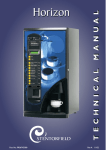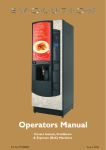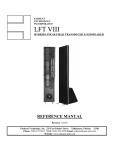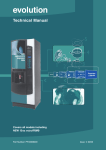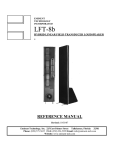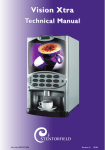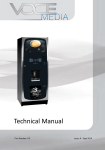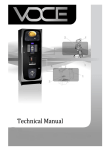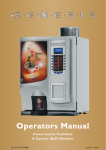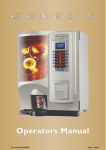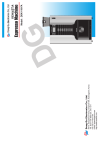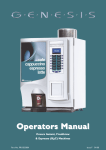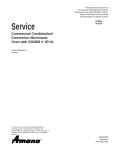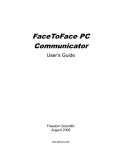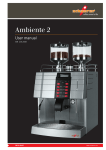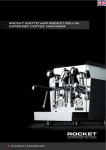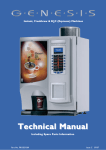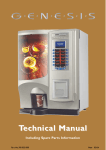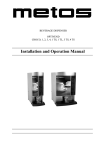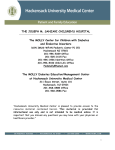Download Vending Range Technical Manual
Transcript
Covers Stentorfield Fusion, Optima, Ventura, Riocca & Eclipse and National Vendors Calico T E C H N I C A L Instant, Freshbrew and B 2 C Models M A N U A L Ve n d i n g R a n ge Part No. PR06651000 Revision C 01/03 Technical Manual Contents Page No. Introduction ...................................................................................................2 Important Safeguards ...................................................................................3 Specifications..................................................................................................4 Section 1 - Installation Procedure ............................................................5 Section 2 - Programming The Machine .................................................11 Section 3 - The Vend Cycle ......................................................................34 Section 4 - Technical Information ...........................................................43 Section 5 - B2C (Bean To Cup) Module ...............................................48 Section 6 - Electrical/Electronic Information .......................................52 Section 7 - Figures and Diagrams ...........................................................63 The following Symbol is used throughout this Technical Manual: Safety First! Take care, risk of personal injury. © Copyright 2002 Crane Merchandising Systems 1 Technical Manual Introduction This technical manual is to be used by all authorised personnel involved in installing, commissioning, programming and servicing Stentorfield Fusion, Optima, Ventura, Riocca and Eclipse machines and the National Vendors Calico. It is the policy of Crane Merchandising Systems to continue developing its range of vending equipment. The technical information presented within this document is for information only and may be changed without prior notice. Crane Merchandising Systems accepts no responsibility for damage caused to the equipment through misinterpretation or misuse of the information contained in this manual. Upon receipt, carefully examine the machine checking for damage or missing / incorrect parts. Any discrepancy must be reported to Crane Merchandising Systems in writing within three days. In accordance with the food hygiene regulations and in compliance with Local Public Health Authorities, it is the responsibility of the operator to keep the machine in a thoroughly clean condition. Ventura and Riocca are registered trade marks. Important Safeguards When installing or servicing the machine, always have this manual available for quick and easy reference and always follow these basic safety precautions: 1. Ensure that the mains electricity supply is isolated before removing any of the protective panels or undertaking any major servicing.Working on live equipment should only be undertaken when there is no practical alternative. 2. Beware of moving components when servicing the machine. 3. Beware of hand entrapment. Never clean or service the brewer unit whilst it is in motion. 4. Servicing the water heating system.Water in the machine can reach a temperature of approximately 96º centigrade. Water at this temperature can cause severe burns!. 5. Machines fitted with carbonator units. The CO2 bottle is filled with a gas at a pressure of 800PSI and MUST be stored in an upright position away from sources of heat. In the event of a leak, ventilate the area in the vicinity of the bottle to 2 Technical Manual remove all traces of gas and contact your supplier. 6. This machine must not be installed in an area where a water jet may be used. Never use a water jet to clean this machine. 7. In normal operating conditions the machine should not freeze-up. In the unlikely event of the machine freezing, turn off the mains water supply, disconnect the machine from the mains electricity supply and contact Crane Merchandising Systems for assistance. 8. When servicing the machine the door switch safety key does not isolate the cold unit which remains live.The cold unit can be isolated using the switch located on the power supply. 9. Ensure that you are conversant with the ‘Health and Safety at Work and Electricity at Work Regulations 1989’. This machine is for indoor use only and because it is a food machine, should be situated in a clean, hygienic area. 3 Technical Manual Specifications Fusion/Ventura/Optima/Calico Riocca Eclipse Height 1830 mm 1830 mm 1830 mm Depth 760 mm 760 mm 760 mm Width 660 mm 740 mm 915 mm Weight 184 kg 210 kg 260 kg Cup Capacity 600 (when using 7 oz. squat cups) Cup Type* 7 oz squat, 7 oz tall and 9 oz tall Electrical Services (i) Voltage (ii) Current (iii) Frequency Water Services (i) Pressure (ii) Stopcock 220 - 240 Volts AC 13 Amp Fused 50 Hz 100 Kpa (1 Bar) - 800 Kpa (8 Bar) 15 mm BSP from rising main All weights and dimensions are approximate and are for guidance only. * Both plastic vending cups (HIPS type) and paper cups (Huhtamaki) can be used in all machines, although modification to the cup drop unit will be required when changing between cup types and sizes. Water Filter - where fitted The National Vendors Calico and Stentorfield range of free-standing beverage vending machines may be fitted with an Everpure or Brita filter head and filter cartridge. To maintain optimum drink quality the cartridge should be replaced at approximately six monthly intervals, depending on the number of vends. IMPORTANT: All bean to cup (B2C) machines must be fitted with an approved water filter to maintain drink quality and machine performance. Please see page 6, “Connecting the Water Supply” for full details. 4 Technical Manual Section 1 - Installation Procedure Important! It is essential that engineers responsible for installing, commissioning and servicing the machine understand the following: 1. The installation and commissioning of the machine should only be carried out by trained and authorised service engineers. 2. All water and electrical services must be correctly and safely connected. 3. All covers should be replaced correctly and securely and the machine left in a safe condition. 1.1 Installing the Machine 1. The machine is suitable for indoor use only, situated in an area with a recommended ambient temperature not below 10º C and not exceeding 30º C. 2. Prior to moving the machine to its location, ensure that there is sufficient access space available via passageways, stairs, lifts, etc. 3. The machine should be located near the appropriate water and electrical services as detailed in the specification tables. 4. To ensure adequate ventilation, 100 - 150 mm (4 - 6 inches) clearance must be allowed between the back of the cabinet and the wall. 5. Unlock and open the cabinet door. Remove all transit packing and the installation kit from the machine. Check for visual signs of damage which may have occurred during transit. Report any problems immediately. 6. The machine should be levelled in both front to back and side to side planes using the four adjustable levelling feet (12 mm thread). Check for correct alignment using a spirit level placed on the floor of the machine. Note! Incorrect levelling can result in: (a) Door misalignment. (b) Coin acceptance reduction. (c) Inconsistent cup drop. 7. Remove the door transport plate screwed to the floor of the machine. 5 Technical Manual 1.2 Connecting the Water Supply 1. The machine should be situated within 1 metre of a drinking water supply from a rising main, terminating with a W.R.C. approved 15mm compression stop tap. 2. Bean to cup machines: Calico, Fusion and Eclipse B2C machines must be connected to the water supply via a water filter.This filter must be of food grade quality and able to remove temporary hardness (scale), heavy metals (lead, copper, iron, cadmium), chlorine and any organic pollutants/discolouration. Crane Merchandising Systems recommend and supply the Brita AquaQuell Compact water filter for its bean to cup vending machines. Note! If the machine is connected to the water supply and used without a water filter as specified above, the warranty will be void. 3. The water supply should comply with both the Statutory Instrument No.1147 “Water, England and Wales” and The Water Supply (Water Quality) Regulations 1989.Water pressure at the stop tap must be within the limits 1 - 8 Bar (100 Kpa 800 Kpa). 4. Connect the flexi-hose supplied with the machine to the stop tap. Ensure that the seal supplied is fitted correctly. Flush the system via the stop tap (several gallons) before connecting the water supply to the machine. 5. Connect the flexi-hose to the inlet valve located on the rear of the machine. Ensure that the seal is correctly fitted. Ensure that all water supply fittings are tight. 6. Turn on the water supply at the stop tap and check for leaks. Prime the water filter (where fitted) following the instructions supplied by the filter manufacturer. 1.3 Connecting the Electrical Supply Safety First! THE MACHINE MUST BE EARTHED. ON NO ACCOUNT SHOULD IT BE EARTHED TO THE WATER SUPPLY PIPE The machine must be connected to a 240 Volt 50Hz 13 amp fused switched socket outlet, installed to the latest edition of the IEE regulations, using a 3 pin BS approved 13 amp fused plug. Important: If the mains lead becomes damaged in any way it must be replaced by a special lead available from the manufacturer. Note! The machines are dispatched ex-factory with the input transformer connected for a 240 Volt supply. If the electrical supply differs, the alternative input tapping (230V or 220V) should be used. 6 Technical Manual 1.4 Commissioning Procedure 1. Ensure that the machine is level, and that there is at least 100 - 150 mm (4 - 6 inches) clearance between the back of the machine and the wall. 2. Ensure that the electrical and water services to the machine are connected correctly. Turn on the stopcock and check for leaks. 3. Remove the soluble ingredient canisters. Remove the fresh beans canister from bean to cup machines. Do not place the canisters on the floor. 4. Fit the door switch bracket to the door using the two screws provided. Ensure that the bracket will operate the door switch when the door is closed. 5. Load cups into the cup carousel. Referring to the illustration, raise bracket (1) and carefully tilt cup carousel assembly forward as shown. Remove the cup carousel lid and fill each of the chambers with one sleeve of cups, avoiding the dispense position. DO NOT TOUCH THE CUPS WITH YOUR HANDS. Ensure that the cups are the correct size for the type of cup turret fitted. Note: If paper cups are being loaded, each pack of cups must first be inspected for damage to the cup rims. Damaged cups must not be used. Replace carousel lid.After the machine is powered up the carousel will rotate until the cups have dropped into the cup ring.The empty chamber can now be filled. 6. Insert the safety key into the door switch. The machine is now ON. 7. Check that the boiler fills to the required level determined by the level probe. Ensure that no water overflows from the boiler tank overflow pipe into the waste tray/bucket. Check the system for leaks. Whilst the boiler is filling the LCD will display the message: SORRY NOT IN USE WATER HEATING Note! The machine has a safety cut-out which will only allow the boiler to fill for a maximum of two minutes. If after software power-up the boiler has not filled within this time, the mains supply should be switched off and then on again to reset the boiler time-out. 7 Technical Manual Bean to cup machines: Once the boiler has reached 75° C the B2C module will initialise and the message on the LCD will change to: B2C MODULE INITIALISING Once the B2C module has finished initialising the machine reverts to stand-by mode. 8. Fill the soluble ingredient canisters with the correct ingredients and re-fit into machine. 9. Bean to cup machines: Fill the fresh coffee beans canister. Ensure that the outlet slide is closed before filling the canister. Refit the canister to the machine. Ensure that the outlet slide is opened to ensure correct operation. 10. Important! Before a B2C machine is used for the first time carry out the Module Filling Procedure, followed by the Module Calibration Procedure as described on pages 45 - 46. 11. Fusion and Calico bean to cup machines: Fill the stick dispenser chute located on the rear of the door. Remove the stirrer weight from the stirrer dispense chute. Referring to the photograph, insert strirrer pack with wrapper into the top of the chute.Tear the wrapper and remove as shown. Add additional stirrer packs as necessary to fill the dispense chute. Replace the stirrer weight to ensure correct operation. (Freshbrew models only - proceed with steps 12 - 15) 12. Load the filter paper roll (provided in the installation kit) onto the support. 13. Press and release the paper feed switch to operate the brewer. When the brewer chamber reaches its fully open position, remove the safety key to switch off the power to the machine. 14. Remove the brewer cover and paper/waste ingredient guard. Feed filter paper under the raised chamber and through the feed wheels. Refit the guard and brewer cover and close the machine door. Filter paper will index automatically and the 8 Technical Manual brewer chamber will return to its closed position. The display will show the message: BREWER REPOSITIONING PLEASE WAIT 15. When the machine returns to standby mode, open the door. Insert the safety key into the door switch. The machine is now ON. Operate the paper feed function once more to check for correct operation of the brewer mechanism. 16. Referring to Section 5 of this manual, ‘Programming the Machine’, use the menu selections available in the Operators and Engineers programs to programme the required settings for correct machine operation. 17. Using the function switches located in a panel inside the top of the door, proceed as follows:(i) Press the Flush switch (switch no. 3). Check that all of the mixing stations are water tight. Note: This operation will also flush the bean to cup brewer fitted to B2C machines. (ii) Press the Cup Test Switch (switch no. 7) and check that the cups drop correctly. (iii) Press the Park Head switch (switch no.9) to ensure that dispense pipes are fitted correctly. (iv) Using the Service switch (switch no. 6), test vend each drink selection. Fusion and Calico bean to cup machines: Ensure that the stick stirrer mechanism operates correctly for vends dispensed with sugar. (v) Press the View Counters switch (switch no.5) and record the audit information. 18. If fitted, check that the coin mechanism and cash box operate correctly. 19. Remove the safety key and close the cabinet door. Check for leaks and ensure that the machine is left in a clean and safe condition. 9 Technical Manual 1.5 Carbonator Unit - Where Fitted 1. Open the cabinet door. Fit the seal (1), provided in the installation kit, to the regulator as shown in the photograph. Connect the regulator to the gas bottle. 2. Tighten the locknut. Carefully lift the cylinder into the machine ensuring that the gas supply pipe is not trapped or obstructed in any way. Safety First! The cylinder may be heavy. Always follow the correct procedure when lifting heavy objects. 3. Turn on the gas supply from the bottle. Ensure that the regulator (2) is indicating a gas pressure of 35 PSI. 4. Remove the carbonator covers. Purge the carbonator of air by lifting the pressure relief valve for approximately 12 seconds. 5. Place the carbonator overflow pipe into the waste bucket. Fill the carbonator water bath with clean cold water until it starts to run from the overflow pipe. Re-fit carbonator covers. 6. Place the syrup containers in the bottom right-hand side of the cabinet and insert the stainless steel dip tubes into the containers ensuring that the correct flavours correspond to the drinks displayed on the selection decals. 7. Switch on the carbonator unit using the carbonator switch located on the power supply. 8. Insert the safety key into the door switch. The machine is now ON. Prime the syrup selections ready for use. Using the function switches (numbered 8, 10 and 12) located in the panel inside the top of the door, press the relevant syrup prime switch to operate the syrup pump for that station. 9. Test vend the carbonated drinks to ensure correct operation of carbonator unit. Check for leaks and ensure that the machine is left in a clean and safe condition. Remove the safety key and close the door.The machine reverts to standby mode. 10 2 Technical Manual Section 2 - Programming The Machine 2.1 Programming Mode To access the Programming Mode you need to enter a sequence of key strokes on the keypad located on the front of the machine.The time between each keystroke must be less than 5 seconds otherwise the machine will return to standby mode. Programming mode utilises the front panel keypad in order to enter values and commands.The keypad layout is illustrated below. During programming the keys are used as follows: 0-9 Keys Used for entering data ‘C’ Key Used for correcting data ‘Blank’ Key For moving to a higher programme level ▲ (Strong) For indexing up in a programme, or incrementing data ▼ (Mild) For indexing down in a programme, or entering data ‘Normal’ Key For entering data in a programme, or moving to a lower programme N.B. In the following programming section, the ‘normal’ key will be referred to as the access key, the ‘strong’ key as the up (▲) key and the ‘mild’ key as the down (▼) key. 2.2 Accessing the Programming Mode 1. Press the program entry switch, mounted in the switch panel located inside the top of the door, followed by the relevant access code - selection button 1 followed by 7 to access the Operators program or selection button 2 followed by 1 to 11 Technical Manual access the Engineers program. Code entry errors may be erased using the cancel (C) key. 2. With the correct code entered the title of the first sub-program will be displayed on the LCD. In the case of the Engineers program the LCD will display the message: KEY PAD TEST SUB PROGRAM 3. To step through the sub-programs, press either the up (▲) or down (▼) keys. 4. To access a displayed sub-program, press the access (normal) key. 5. When a parameter is displayed that requires changing, press the access key. Numerical data can now be changed in one of two ways: (a) Pressing the up (▲) or down (▼) keys increases or decreases the number on each key press. (b) Keying in the actual digits of the number required. Using this method, the new number will be displayed in place of the current parameter. 6. Once the correct number has been entered, press the access key to overwrite the previous parameter with the new value. to retain the previous parameter press either the ‘blank’ or cancel (C) key. Note: It is not possible to vend a drink whilst in Programming Mode. 12 Technical Manual 2.3 Operators Program The nine sub-programs within the Operators program are as follows:Drink Price Sub-Program Alternative Tariff 1 Sub-Program Alternative Tariff 2 Sub-Program Alternative Price Period Sub-Program Drink Disable Sub-Program Non Resetable Vend Counters Sub-Program Time/Date Sub-Program Self Clean Sub-Program Operator Code Sub-Program To access a sub program within the Operators Program, enter the programming mode as described previously. To step through the sub programs, press either the up (▲) or down (▼) keys.To enter a displayed sub program, press the access key. 1. Drink Price Sub-Program (Default = 10) 1. The drink price sub-program allows the normal tariff prices to be individually set for each drink. 2. Upon entry into this sub-program, the name of the first drink is displayed, followed by its price. On instant and freshbrew models the LCD will display the following message: TEA PRICE = 10 3. To alter the drink price, press the access key. The LCD will display the following message: TEA PRICE > 10 4. The = symbol changes to a > symbol indicating that it is now possible for new data to be entered. Key in the new price using the keypad and when correct press 13 Technical Manual access to overwrite the old data. 5. The prices for other drinks can now be set following the sequence described in section 2.2 - Accessing the Programming Mode. 6. On certain machines a cup discount price can also be set within this sub program, providing that the feature has been enabled within the Engineers Program.With the cup discount feature enabled, the operator may set a discount price against drink selections. When a customer presses the “No Cup” button before selecting a drink, the drink will be dispensed into the customers own cup. The price set for cup discount is then subtracted from the price of the drink selected and change/credit given accordingly. 2. Alternative Tariff 1 Sub-Program (Default = 15) This sub-program works in exactly the same way as the drink price sub program and has the same appearance. The prices set in this program will be in force during tariff 1 periods. 3. Alternative Tariff 2 Sub-Program (Default = 20) This is identical to the alternative tariff 1 sub-program except that the prices set here will be in force during tariff 2 periods. 4. Alternative Price Period Sub-Program This sub-program enables the times to be specified when each of the above tariffs should be in force.There is a four level tariff structure available: 1. Normal Tariff: This relates to prices set in the drink price sub-program and in force when no alternative price period is currently applicable. 2. Tariff 1: Prices set in the tariff 1 price sub-program. 3. Tariff 2: Prices set in the tariff 2 price sub-program. 4. Tariff 0: Sets the machine into free vend. 14 Technical Manual The machine is factory set to the normal tariff, with no alternative prices available.To change the tariff period, proceed as follows:1. On entry into the sub-program the display will show the message: P1 = 00:00 - 00:00 TARIFF - EVERY DAY 2. This is an empty price period.To enter a price period (e.g. 10:30 - 15:45,Tariff 2, Weekends), press access.The display will now read: START > 00:00 Note: The arrow symbol (>) indicates that it is possible to update the display. 3. Enter the correct start time in hours and minutes using buttons 0 - 9 on the keypad. Note: To correct any entry errors, press cancel to delete the last digit entered. Pressing cancel with no digits displayed will exit to the Operators program. 4. With the start time entered press access. Enter the finish time as described above and press the access key.The display will now show: PERIOD 10:30 - 15:45 TARIFF > 0 5. To set the tariff period, enter a number between 0 and 2 (or use the up (▲) or down (▼) keys) followed by access.The message will change to: PERIOD 10:30 - 15:45 TARIFF 2 > EVERYDAY 6. Using the up (▲) and down (▼) keys, index the day setting between “Every day”, “Weekdays” and “Weekends”. When the required day setting is displayed, press the access key to complete the price period data entry. The message on the display will read: PERIOD 10:30 - 15:45 TARIFF 2 EVERYDAY 7. There are a maximum of ten possible price periods available. To enter another price period, use the up (▲) or down (▼) keys to view the periods until an empty 15 Technical Manual period is displayed. The new period is entered in the same way as described previously. 8. If the start time is entered as being a later time than the finish time, the period will not be accepted by the machine. If periods overlap, the first overlapping period in the list will be the one in force until it has finished. To delete a period, continue as if that period were to be re-programmed, and when the display is requesting the start time to be entered, press cancel. Drink Disable Sub-Program This sub-program allows drinks to be either enabled or disabled.The following example illustrates the sequence required to disable the chocolate selection. 1. Enter the drink disable sub-program and scroll up or down using the appropriate arrow key until the message on the LCD display reads: CHOCOLATE = ENABLED 2. Press the access key. The message on the display will now read: CHOCOLATE > DISABLED 3. Press the access key again.The drink is now disabled. 5. Vend Counters Sub-Program 1. When the vend counters sub-program is entered, the first drink counter is displayed: COFFEE 1372 2. The up (▲) and down (▼) keys enable the counters for each drink to be viewed, and values noted, but they cannot be altered using the keypad.These counters can only be reset by using the ‘reset counters’ switch (see page 21). 3. There is one vend counter for each drink, plus counters for jug vends, free vends, total vends and total sales value.The total sales data is displayed in units of 1 penny. 16 Technical Manual 6. Time/Date Sub-Program The machine maintains a record of the current time and date in 24-hour format. The date is programmed for leap-year roll-over and should not require adjustment. To set the time and date, proceed as follows: 1. The Time/Date sub-program displays the time, date and day of the week. The up (▲) and down (▼) keys are used for viewing the three different messages. 2. To view the time, enter the time/date sub-program. The display will show the message: TIME = XX:XX where xx:xx is the current time. 3. To change the time shown, press the access key.The display will now show: TIME = XX:XX SET TIME > 00:00 4. Enter the correct time in hours and minutes using buttons 0 - 9 on the keypad. 5. When correct, press access. The time is now set. To view the date, press the up or down key until the display reads: DATE = XX:XX:XX where xx:xx:xx is the current date. 6. To change the date, press the access key.The display will now show: DATE = XX:XX:XX SET DATE > 00:00:00 7. Enter the correct date using the sequence day, month, year using buttons 0 - 9 on the keypad. 8. When correct, press access.The date is now set. 17 Technical Manual 9. To view the day, press the up or down key until the display reads: DAY = XXXXXXXXX where xxxxxxxxx is the current day of the week. 10. To change the day, press the access key.The display will now show: DAY = XXXXXXXXX > XXXXXXXXX 11. Use the up or down arrow keys until the required day is displayed. Press the access key. The time, date and day are now programmed. 7. Self Clean Sub Program 1. This sub program allows the operator to define two periods during a day when the machine will automatically flush through the water system. 2. Depending upon the flush setting which will have been pre-programmed via the Engineers Program, the machine will have been set to flush hot system only, cold system only or complete water system. 3. Auto flush periods can be programmed by the operator to occur everyday, weekdays, weekends or never. 4. To enter auto flush periods, enter the self clean sub program and follow the sequence for setting an alternative price period described on pages 14 - 16. 8. Operator Code Sub-Program (Default 17) Entry into the Operator code sub-program enables the operator code to be changed. This code may be of any length up to seven digits. Enter a new code at the prompt and when correct press the access key. 18 Technical Manual 2.4 Engineers Program (Default 21) The sub-programs within the Engineers program are as follows:- 19 Technical Manual 1. Keypad Test Sub-Program The keypad test sub-program enables the engineer to test each key on the keypad to ensure that it is operating correctly. 1. Whenever a key is pressed, the name of that key will be displayed on the LCD. Because the access key was pressed to enter the sub-program, on entry to this sub-program the LCD will display: ACCESS KEY 2. For numerical keys, the number will be displayed, such as ‘1’ key or ‘2’ key. For other keys, the name of the key will be displayed, such as ‘Strong’ or ‘Mild’. 3. To exit from this sub-program into the engineer program, press the ‘Blank’ key. 2. Drink Ingredient Sub-Program The drink ingredient sub-programs allow the ingredient quantities for each drink to be adjusted to accommodate different ingredient types and taste requirements. Proceed as follows: 1. On entry into the ingredient sub-programs, the first ingredient to be displayed is the ingredient which constitutes the major part of the drink. In the case of tea, this will be: TEA INGREDIENT = 40 2. All ingredient quantities are displayed in twentieth of a second increments. Therefore a quantity of 40 actually means that the ingredient is dispensed for forty twentieths, or two seconds thus simplifying the calculation of ingredient quantities. The engineer does not need to consider the exact weight or volume of ingredient and has an immediate idea of the approximate time taken to dispense a sensible quantity. 3. The quantity may be altered in the same way as other parameters are programmed. Depending on the drink type, there may be a number of different ingredient values to be adjusted. For each ingredient value there is an associated water value, again measured in twentieths of a second. 4. The diagram (page 21) illustrates the ingredients that may be involved in the makeup of a drink. The chocomilk sub-program is used as an example. Not all drinks 20 Technical Manual will involve this amount of ingredient, most will only contain a main ingredient and water. 5. The maximum parameter allowed for any one ingredient quantity is 255 except when programming jug vends 3. Output Test Sub-Program This sub-program enables the engineer to individually test each output of the machine. 1. On entry into the sub-program the LCD will display the first output (Cup Drop Solenoid), with its present state (off) beneath it. CUP DROP SOLENOID OFF 2. Pressing the arrow keys allows the engineer to cycle through the outputs in turn, displaying the name of each one. In order to test an output, press the ‘1’ key to switch it on, and the ‘0’ key to switch it off. The caption at the bottom of the LCD will show the current state of the output. If the output is left ‘ON’ for more than three seconds the protection circuit will switch it ‘OFF’, even though the display will still indicate that it is ‘ON’. This prevents damage to the motors. 3. When a different output is selected, or the sub-program exited, the previous output is automatically switched ‘OFF’. Note: It is not possible to test the heater using the output test sub-program. Serious damage may occur if there is insufficient water in the boiler when the heater is turned on. 4. Input Test Sub-Program This sub-program enables the engineer to individually test each of the input lines. 1. The operation of the input sub-program is similar to the output test sub-program 21 Technical Manual except that the display shows the name of the input and the caption indicates its’ current state: COIN INPUT 1p OFF 2. As the state of the input changes, so does the caption at the bottom. There is a delay of approximately three-quarters of a second before the display caption changes to ensure that any rapid changes can be seen. 5. Initialise Sub-Program The initialise sub-program enables the engineer to return all the parameters to their factory settings. 1. Upon entry into the initialise sub-program, the display will show the message: USE ACCESS KEY FOR INITIALISATION 2. To initialise the machine, press access. The display will now show: INITIALISED 3. The LCD will flash this message accompanied by an intermittent beep.To return to the Engineers program or standby mode, it is necessary to press the ‘cancel’ button. This ensures that should the initialise sub-program ever be inadvertently activated, the engineer cannot overlook the fact that the machine has been initialised. 6. Cup Level Sub-Program 1. The cup level sub-program allows the amount of water used in each cup vend to be altered on a percentage basis. This enables different size cups to be used without having to change each drink ingredient quantity. Jug vends remain unaffected. 2. The sub-program will display the percentage cup level which may be altered in the same way as all other parameters. 100% cup level will dispense the exact amount of water set in the drink ingredient sub-programs. 3. A percentage below 100 will dispense less water, and a percentage above 100 will dispense more. 22 Technical Manual 7. Management Sub-Program The management sub-program informs the controller which hardware aspects of the machine have been selected with respect to the following: 1. Coin System The “Coin System” program displays the type of coin system selected. To change the selection, press the access key followed by the up (▲) or down (▼) keys to display the required selection. Enter the new selection by pressing the access key. If the machine is not fitted with a coin system, the option “Free Vend Only” should be selected. 2. Cold Drink Unit Entry into the “Cold Drink Unit” program will display the type of drink system selected, either ‘carbonated’, ‘still’ or ‘hot only’.To change the selection, press the access key followed by the up (▲) or down (▼) keys to display the required selection. Press the access key to store the new selection. 3. Flush Entry into the “Flush” program will display which flush option has been selected, either ‘hot only’, ‘cold only’ or ‘hot and cold’. To change the selection, press the access key followed by the up (▲) or down (▼) keys to display the required selection. Press the access key to store the new selection. 4. B2C Module Filling - Bean to Cup Machines Whenever a B2C machine is moved, module repaired/replaced or the engineer is unsure of the state of the B2C module, a module fill should be carried out. Before a B2C fill is carried out ensure the water waste container is in position and empty. To carry out a B2C fill, press the access key twice. After the first press the LCD will display the message: PRESS ACCESS TO FILL B2C MODULE Following the second key press approximately 140ml of water will be pumped through the B2C system ensuring the system is free from air. 5. Calibrate B2C Module - Bean to Cup Machines The following section describes the procedure for calibrating the B2C module. This procedure must always be carried out by the engineer before the B2C vending machine is used for the first time, when the beans are changed or when the module has been removed/repaired. 23 Technical Manual Proceed as follows: Important: Before commencing the following procedure, ensure that you have a set of gram scales and a cup with which to catch the coffee. Using the ‘tare’ function, calibrate the cup with the gram scales. 1. Open the door and insert the safety key. Ensure that the brewer waste bucket/coffee grounds container is in position, the bean hopper is fitted and contains beans and the hopper outlet slide is open. Remove the four screws securing the brewer guard and remove the guard. 2. With the machine at working temperature, press and release the program entry input switch (No1) located in the switch panel on the rear of the door. Key in the Engineers program entry code using the numeric keypad. 3. Press the down (▼) key until the display shows MANAGEMENT SUB-PROGRAM. 4. Press the access (normal) key, followed by the down (▼) key until the display shows MANAGEMENT CALIBRATE B2C MODULE. 5. Press the access key. The display will show CURRENT GRAM THROW IN 4s IS XX.Xg. After 2 seconds the display will change to PRESS ACCESS KEY TO PRIME GRINDER. 6. Press the access key to start the priming process.After 4 seconds the grinder will stop and the brewer will reposition. 7. The display will now show PRESS ACCESS KEY TO CALIBRATE B2C MODULE. Position the calibrated cup with its rim touching the clear plastic pipe that enters at the bottom of the brewer as shown in the photograph. Press the access key. After 4 seconds the grinder will stop and dry, ground coffee will be ejected into the cup.The display will now show ENTER COFFEE WEIGHT IN g > 00.0g. Weigh the coffee in the cup and enter the weight into the machine. If the weight of ground coffee was 10.8grams, enter 1 0 8 on the keypad then press the access key to store the value. 8. Repeat step 7 twice more. Upon completion the display will show CALIBRATION COMPLETE - NEW VALUE IS XX.Xg, where XX.X is the new calibrated value. Press the cancel key to return the machine to stand-by mode. Calibration is now complete. 9. Refit brewer guard and secure with the four fixing screws. Remove the safety key and close the door. N.B. In order to prevent unrealistic and therefore potentially damaging values being 24 Technical Manual entered there is a minimum and maximum value of coffee weight that can be entered, they are as follows: - minimum value = 8.00g, maximum value = 14.00g. 6. Option Drink - Not Available on all Machines The “Option Drink” program displays the drink option selected, either ‘single ingredient’ or ‘multi ingredient’.To alter the selection, press the access key followed by the up (▲) or down (▼) keys to display the required selection. Press the access key to store the new selection. Note: The Option Drink program is only active in Stentorfield Fusion freshbrew and 6 canister instant machines when the chocolate cappuccino sub program is enabled within the “Miscellaneous Settings” sub program. 7. Station 2 Selection - 6 Canister Instant Fusion Machines Only This program allows the engineer to set up the second station within instant Fusion machines to dispense either tea or coffee.To change the selection, press the access key followed by the up (▲) or down (▼) keys until the required selection is displayed. Press the access key to store the selection. Important: Because the product in station 2 has been reconfigured, it will be necessary to initialise the machine in order to reset correct ingredient and water timings and also reset the counters.The Initialise Sub Program is detailed on page 22. 8. Freshbrew Station - Freshbrew Fusion Machines Only Entry into this program will display the freshbrew selection currently available.To change the selection, press the access key followed by the up (▲) or down (▼) keys until the required selection is displayed. Press the access key to store the selection. Important: Because the freshbrew selection has been reconfigured, it will be necessary to initialise the machine in order to reset correct ingredient and water timings and also reset the counters.The Initialise Sub Program is detailed on page 22. 9. Instant Station - Freshbrew Fusion Machines Only The “Instant Station” program displays the drink type available from Instant station 1 within freshbrew Fusion machines.To alter the drink selection available from this station, press the access key followed by the up (▲) or down (▼) keys until the required selection is displayed. Press the access key to store the selection. Important: Because the drink selection assigned to instant station 1 has been reconfigured, it will be necessary to initialise the machine in order to reset correct ingredient and water timings and also reset the counters. The Initialise Sub Program is detailed on page 22. 25 Technical Manual Note: The software installed into Fusion freshbrew machines will not allow both the freshbrew and instant stations outlined above to be set to dispense Tea. One station must always be set to dispense a coffee selection. 8. Coin Set Sub-Program The coin set sub-program enables the coin set to be changed to suit the coin mechanism which has been connected to the machine. Although the actual coin set used by the coin mechanism is totally transparent to the controller,this will ensure that the displayed message in the standby mode correctly indicates which coins may be entered. The possible coin sets are: 1p - 20p 1p - 50p 5c - 20c 5c - 50c 1p - 100p 5c - 5p - 50p 5p - 100p 5p - 200p 5c - 1 2 These are selected in the same way as parameters in the “management sub-program”. Note: This sub-program is not accessible if “Free Vend Only” or “Card System” is selected in the management sub-program. 9. Miscellaneous Settings Sub-Program The miscellaneous settings sub-program allows various delays and timings to be set which will affect all of the drinks in the machine. These settings may be viewed and changed in the same manner as the parameters in the ingredient sub-programs. 1. Cup Drop To Water Start Delay The cup drop to water start delay defines the time between the cup drop solenoid operating and water starting to dispense.This ensures that the cup is allowed to fall into its correct position before water reaches the dispense head. 2. Water Start To Ingredient Start Delay The water start to ingredient start delay defines the time between water starting to be dispensed and the ingredient starting to be dispensed. If ingredient reaches the mixing bowl before the water, it may stick to the sides of the bowl.This delay ensures that ingredient is always dispensed into a bowl already containing water. 3. Water Stop To Whipper Stop Delay The water stop to whipper stop delay defines the length of time that the whipper will continue to run after the water valve has closed.This ensures that the whipper 26 Technical Manual operates whenever there is water in the mixing bowl. 4. Strong Increase This defines the amount of extra ingredient to be dispensed for a “strong” drink and is added to the amount of ingredient set in the ingredient quantity subprograms. 5. Mild Decrease The mild decrease defines the amount of ingredient to be subtracted from the amount set in the ingredient quantity sub-programs when a “mild” drink is requested. 6. Water Flush Time This setting is the period of time that a hot dispense valve is opened during a flush cycle. It is generally set slightly higher than the period set for a vend to ensure that the mixing bowl is filled further than during a vend. Care should be taken to ensure that the period set does not cause the bowl to overflow. 7. Carbonator Flush This defines the period of time that each cold water valve operates during the carbonator flush cycle. 8. Brewer Delay The brewer delay allows the brewer to stop part way through its cycle enabling a drink to brew for a longer period before the cycle continues. 9. No-Cup Button Enable This program allows the no-cup button to be enabled or disabled as required. When enabled, should the no-cup button be pressed, a cup will not be dispensed with the drink. If a drink is not selected within fifteen seconds of pressing the nocup button, the option will be cancelled. 10. Electronic Waste Probe This sub-program enables the engineer to disable the electronic waste probe should the machine be fitted with a waste bucket pressure switch. 11. Cup Discount - Not Available on all Machines This program allows the cup discount feature to be enabled or disabled as required.To ensure that this feature operates correctly both “Cup Discount” and “No-Cup Button” must be set to enable. With “Cup Discount” enabled, when a customer presses the “No Cup” button before selecting a drink, the drink will dispensed without a cup.The price set for “Cup Discount” in the drink price sub program is then subtracted from the price of the drink selected and change/credit given accordingly. 27 Technical Manual 10. Jug Ingredient Sub-Programs The jug ingredient sub-programs determine the ingredients for jug vends. Since instant jug vends are always black with no sugar, the only quantities which need to be entered are ingredient and water.The maximum quantity allowed for each is 1499. For freshbrew jug vends the number of cups for each jug is entered. 11. Non-Resettable Vend Counters Sub-Program 1. When the vend counters sub-program is entered, the first drink counter is displayed: TEA 1372 2. Pressing the up (▲) or down (▼) keys enables the counters for each drink to be viewed, but they do not allow the counters to be altered. 3. There is one vend counter for each drink, plus counters for each jug vend, total vends and total sales vends. Additionally, an “Engineer Entry” counter is incremented each time the Engineers program is accessed.These counters cannot be reset and will remain intact for the service life of the controller board. 12. Engineer Code Entry Sub-Program (Default 21) Entry into the engineer code entry sub-program allows the engineer code to be changed. This code may be of any length up to seven digits. Enter a new code at the prompt and when correct, press access. Note: If a zero code is entered, the machine will remain in the Engineers program continually, so the zero code will have to be withdrawn. A code of zero is also entered if the engineer attempts to alter the code and then exits the sub-program without entering any number. 13. Temperature Sub-Program The temperature sub-program allows the parameters controlling boiler temperature and temperature display to be altered. There are four parameters which may be altered. 1. Maximum Temperature This is the maximum temperature to which the water will be heated and maintained at and must be set to a value greater than the minimum temperature. 28 Technical Manual 2. Minimum Temperature This is the minimum water temperature at which a drink may be dispensed. If an attempt is made to vend a drink with the temperature below this value when minimum temperature is enabled, the following message will be displayed: SORRY NOT IN USE WATER HEATING 3. Minimum Temperature Enable / Disable This feature allows the engineer to enable or disable the vending of drinks below the minimum temperature. 4. Temperature Display Allows the actual temperature to be displayed (free vend only). 14. Software Version Sub-Program The software version sub-program displays the serial number of the software version running on the machine and is for information only. 2.5 Vend Counters 1. The vend counters record the number of drinks/jug vends dispensed and the prices charged for them. Each drink type has a separate counter with an additional counter for each jug vend. A “Total Vend” counter keeps a record of the number of vends dispensed and is incremented each time a drink is dispensed. 2. The counters are accessible from within both the operator's and engineer's programs. From the operator's program they may be reset using the “Reset Counters” function or the “Engineers Initialise Sub-Program”.When accessed from within the Engineers program, the counters are non resettable.This ensures that a cumulative record is kept throughout the service life of the controller board. 3. Each time the Engineers program is entered, an “Engineer Entry” counter is incremented.This acts as a security feature, ensuring that the Engineers code may not be used without leaving evidence that the program has been entered. 29 Technical Manual 2.6 Pre-Set Values The tables on the following pages illustrate the pre-set values for all of the parameters which may be changed in the Operators or Engineers programs.These are the values with which the machine leaves the factory. If the “Initialise” sub-program is activated, each one of these values will be restored into the memory of the controller. The pre-sets for the parameters found in the Operators program are: Vend Counters Time and Date Drink Type Counter Pre-Set Parameter Setting Drink Counters 0000000 Time (24 Hr. Clock) Jug Counters 0000000 Date 1: 1: 90 Free Vends 0000000 Day of the Week Monday Total vends 0000000 Total Drink Value 0000000 Drink Prices Drink Type 00:00 Self Clean Sub-Program Normal Tariff Tariff One Tariff Two Hot Water 0 0 0 Cold Water 0 0 0 All Other Drinks 10 15 20 Period Time Day One 07:30 Everyday Two 19:30 Everyday Alternative Price Periods 30 Period Start Time End Time Tariff Day Type One 00:00 00:00 - Every Day Two 00:00 00:00 - Every Day Three 00:00 00:00 - Every Day Four 00:00 00:00 - Every Day Five 00:00 00:00 - Every Day Six 00:00 00:00 - Every Day Seven 00:00 00:00 - Every Day Eight 00:00 00:00 - Every Day Nine 00:00 00:00 - Every Day Ten 00:00 00:00 - Every Day Technical Manual The pre-sets for the parameters found in the Engineers program are: Instant Selections - All machines except Fusion & Calico Ingredient Decaff. Coffee Coffee Option* Tea Coffee Jug Decaff Jug Main Ingredient 20 20 20 4 150 150 Main Water 80 80 80 80 1000 1000 Milk Ingredient 15 15 15 8 N/A N/A Extra Milk Ingredient 22 22 22 12 N/A N/A Sugar Ingredient 22 22 22 12 N/A N/A Extra Sugar Ingredient 30 30 30 15 N/A N/A Milk/Sugar Water 80 80 80 80 N/A N/A * If “Option” is set to single ingredient, only main ingredient and main water settings apply. Speciality Drinks Choc Ingr. Choc Water Caffe Mocha 55 65 Chocolate 55 150 Chocomilk 55 85 Cappuccino Espresso Coffee Ing. Coffee Water Topp. Ing. Topp. Water Sugar Ing. 40 50 30 80 20 20 30 17 36 17 55 30 80 Ingredient Milk Ing. Mlk/Sgr Water 35 Water Option 30 150 Hot Milk 30 150 Hot Water 0 150 Instant Selections - Fusion & Calico Machines Ingredient Decaff. Coffee Coffee Option* Tea Coffee Jug Decaff Jug Main Ingredient 20 20 14 (30) 4 150 150 Main Water 80 80 80 (150) 80 1000 1000 Milk Ingredient 15 15 15 8 N/A N/A Extra Milk Ingredient 22 22 22 12 N/A N/A Sugar Ingredient 22 22 22 12 N/A N/A Extra Sugar Ingredient 30 30 30 15 N/A N/A Milk/Sugar Water 80 80 80 80 N/A N/A * Figures in brackets () denote single ingredient option. 31 Technical Manual Speciality Drinks Choc Ingr. Choc Water 20 35 Cappuccino (i) 55 Coffee Water 15 45 40 50 65 20 30 20 30 Cappuccino (ii) Caffe Mocha (i) Coffee Ing. Caffe Mocha (ii) 55 65 Chocolate 55 150 Chocomilk (i) 55 85 Chocomilk (ii) 55 85 Espresso 30 Topp. Ing. Topp. Water Sugar Ing. Milk Ing. 12 30 30 80 20 17 36 17 55 80 Mlk/Sgr Water 50 35 30 36 30 55 10 20 (i) Settings with Chocolate Cappuccino enabled. (ii) Settings with Chocolate Cappuccino disabled. Ingredient Water Option 30 150 Hot Milk 30 150 Hot Water 0 150 Freshbrew Selections - where applicable Ingredient Freshbrew Coffee Freshbrew Decaf. Coffee Freshbrew Tea Main Ingredient 50 50 30 Main Water 150 150 150 Milk Ingredient 15 15 5 Extra Milk Ingredient 22 22 10 Sugar Ingredient 10 10 10 Extra Sugar Ingredient 20 20 20 Milk/Sugar Water 40 40 40 Cups Per Jug 6 6 6 Speciality Drinks Cappuccino (i) Choc Ingr. Choc Water 15 15 Cappuccino (ii) Coffee Ing. Coffee Water 60 80 40 50 Caffe Mocha (i) 45 55 40 60 Caffe Mocha (ii) 55 65 20 30 Chocomilk (i) 55 85 Chocomilk (ii) 55 85 Espresso (i) 50 80 Espresso (ii) 50 80 Topp. Ing. Topp. Water Sugar Ing. Milk Ing. 2 25 30 80 20 17 36 17 55 10 Mlk/Sgr Water 30 35 25 36 30 55 20 (i) Settings with Chocolate Cappuccino enabled - Fusion/Calico machines only. (ii) Standard settings for all freshbrew machines and Fusion/Calico machines with Chocolate Cappuccino disabled . 32 Technical Manual B2C Selections - Bean To Cup Machines Fusion, Calico and Eclipse Drink Choc Ingr. Choc Coffee Coffee Water Ing. Water Topp. Ing. Topp. Water Sugar Ing. Milk Ing. 15 Fresh Coffee 8.7g 100 20 Espresso 8.7g 60 20 Americano 8.7g 60 Cappuccino 9.5g 80 Caffe Latte Caffe Mocha 24 24 Mlk/Sgr Extra Water Water 40 25* 20 28 80 40 20 25* 20 25* 7.8g 80 40 60 7.8g 80 28 28 * Fusion/Calico Machines: Sugar is dispensed dry therefore value is set to 0. Minimum coffee setting = 7.3g Maximum coffee setting = 16.0g Cold Drink Sub-Program Cold Drink 1 Miscellaneous Settings Parameter Setting Syrup 1 20 Cold Water 125 Carb. Water 140 Cup Drop to Water Stop 20 Water to Ingredient Start Delay 20 Cold Drink 2 Water to Whipper Stop Delay 50 Syrup 1 20 Strong Increase 10 Cold Water 125 6 Carb. Water 140 Mild Decrease Flush Water Time 100 Carbonator Flush 200 Cold Drink 3 Tea Brewer Delay 10 Syrup 1 20 Coffee Brewer Delay 0 Cold Water 125 No Cup Button Disabled Carb. Water 140 Electronic Waste Probe Enabled Cold Water General Parameters Cup Level Coin System Coin Set Water 140 Carb. Water 150 Temperature Sub-Program 100% Change-giver 1 - 50p Cold Drink Unit Carbonator Flush Hot & Cold Max.Temperature Min. Vend Temperature 90° C 75° C Min.Temperature Disabled Temperature Display Disabled 33 Technical Manual Section 3 - The Vend Cycle 3.1 Standby Mode In standby mode the machine is idle, awaiting action from the keypad or switch/key inputs. The display will show one of a number of messages indicating the credit mechanism of the machine, the coin set, the time and if appropriate, which alternative tariff is in force. The messages displayed are determined by the type of coin system which has been programmed in the management sub-program. The credit mechanism is indicated by one of the following prompts: 1. ‘Free Vend’ - indicates that a free vend tariff is in force. 2. ‘Please Insert Card’ - indicates that a card system is attached. 3. ‘Please Insert Coins’ - indicates that a coin mechanism is connected. 4. ‘Please Insert Key’ - indicates that the machine is fitted with a key system. In addition, the prompts ‘Exact Change Please’ or ‘No Change Given’ inform the customer whether change is available. If the mechanism is set to acceptor, the ‘No Change Given’ message will always be displayed. If the mechanism is set to change-giver, the prompt will depend upon how full the change tubes are. For more information please refer to the manual supplied with the change-giver.The coin set accepted by the coin mechanism is displayed. This is pre-set in the controller and outlined in the section covering the programming of the coin set in the Engineers program.The alternative tariff will be indicated by either the “Alternative Prices” or “Free Vend” messages. An example of the display in standby mode for a change-giver with full tubes, and alternative tariff 1 in force at 10:30 a.m. would be: Message No. 1: Message No. 2 Message No. 3 PLEASE INSERT COINS 1 - 50p TIME 10:30 CHANGE GIVEN ALTERNATIVE PRICES NOW AVAILABLE Each message will be displayed in turn for approximately 21⁄2 seconds. 34 Technical Manual 3.2 Drink Numbering Each drink available from the machine has its own unique number which must be entered from the keypad. Drink numbering and prices are displayed to the customer by a set of polycarbonate or self adhesive decals depending on machine type. Separate, self adhesive decals are applied to the main decal to indicate the drink prices. The numbering sequence is illustrated in the following tables: 1. Instant and Freshbrew Machines Attributes Instant Coffee Freshbrew Coffee Instant Decaff Coffee Instant & Freshbrew Tea Freshbrew Decaff Coffee Milk Sugar 10 20 20 30 90 Milk Extra Sugar 11 21 21 31 91 Milk No Sugar 12 22 22 32 92 Extra Milk Sugar 13 23 23 33 93 Extra Milk Extra Sugar 14 24 24 34 94 Extra Milk 15 25 25 35 95 Sugar 16 26 26 36 96 Extra Sugar 17 27 27 37 97 No Sugar 18 28 28 38 98 Jug 19 29 29 39 99 Note: Instant Decaffeinated Coffee selections are numbered 90 - 99 in Fusion and Calico machines. Selections Cold Drink Selections Chocolate 40 Drink 1 (Still) 60 Option 1 41 Drink 1 (Carbonated) 61 Option 2 42 Drink 2 (Still) 70 Cappuccino (+ Sugar) 50 Drink 2 (Carbonated) 71 Cappuccino (No Sugar) 51 Drink 3 (Still) 72 Espresso 52 Drink 3 (Carbonated) 73 Espressochoc 53 Cold Water (Still) 80 Milk 54 Cold Water (Carbonated) 81 Chocomilk 55 Hot Water 82 Hot Water (No Cup) 83 35 Technical Manual 2. Fusion, Calico and Eclipse Bean to Cup Machines Attributes Instant Coffee Fresh Coffee From Beans Instant/Freshbrew Tea Milk Sugar 10 20 30 Milk Extra Sugar 11 21 31 Milk No Sugar 12 22 32 13 23 33 Extra Milk Sugar Extra Milk Extra Sugar 14 24 34 Extra Milk 15 25 35 Sugar 16 26 36 Extra Sugar 17 27 37 No Sugar 18 28 38 Jug 19 29 39 Selections Cold Drink Selections Chocolate 40 Drink 1 (Still) Option 41 Drink 1 (Carbonated) 61 70 60 Espresso 90/91 Drink 2 (Still) Americano 92/93 Drink 2 (Carbonated) 71 Cappuccino 94/95 Drink 3 (Still) 72 Caffe Latte 96/97 Drink 3 (Carbonated) 73 Cold Water (Still) 80 Cold Water (Carbonated) 81 Caffe Mocha 98 3.3 Replacing/Updating Drink Selection Decals To update drink pricing or replace drink description decals, proceed as follows: 1. Riocca, Eclipse & Calico Machines 1. Ensure that the machine is switched off and disconnected from the mains electricity supply. Open the cabinet door. 2. Remove the two fixing nuts situated either side of the cup turret that secure the drop down front graphic panel. 3. Moving to the front of the door, carefully pull down the hinged top graphic panel. Remove the relevant decal(s) from the slide in pocket and update as appropriate. 36 Technical Manual 4. Close the hinged graphic panel and secure using the fixing nuts. Close the front door and switch on the power to the machine. 2. Fusion Machines 1. Ensure that the machine is switched off and disconnected from the mains electricity supply. Open the cabinet door. 2. Unscrew the two knurled fixing sleeves located either side of the cup turret and carefully remove the decal carrier plate from the front of the machine. 3. Remove the transparent window and printed decal carrier from the decal carrier plate. Remove the relevant decal strip(s) from the slide in pockets and update as required. 4. Refit the printed decal carrier and transparent window to the decal carrier plate. Replace the decal carrier plate to the front of the machine and secure with the knurled fixing sleeves. 5. Close the front door and switch on the power to the machine. 3. Ventura and Optima Machines 1. Ensure that the machine is switched off and disconnected from the mains electricity supply. Open the cabinet door and lower the cup turret. 2. Carefully push the relevant transparent decal holder(s) out of the moulding. Remove old decal from holder and replace/update as required. Refit holder(s) to moulding. 3. Close the front door and switch on the power to the machine. 3.4 Drink Selection Drink selections are made by entering the two digit number for the drink required as shown in the previous tables. Any numerical entry errors may be corrected using the ‘C’ key.This will cancel the last digit displayed on the LCD. In this section, we shall use the example of vending a drink number 20, with the machine in “Free Vend Mode”. 1. Immediately a numerical key is pressed (in this case number 2), the controller will exit standby mode and display: DRINK 2 CREDIT 0.00 37 Technical Manual 2. On entering the second digit (0) the message on the display will change to: DRINK 20 STRENGTH? CREDIT 0.00 3. The ‘strong’, ‘mild’ or ‘normal’ buttons should now be pressed to select the drink strength. Pressing one of these buttons activates the controller and the specified drink is dispensed. If the drink selected does not have a strength option, the ‘strength’ prompt will not be displayed. 4. If a button is not pressed within five seconds of the drink number being entered, a normal strength drink will be dispensed. The five second delay is to enable the user to alter an incorrectly entered drink number. 5. While the drink is being vended, the display will show the message: DRINK 20 PLEASE WAIT CREDIT 0.00 6. After dispensing the drink, the machine will display the message shown below before returning to background mode: THANK YOU FOR YOUR CUSTOM 7. Assuming that the same sequence of operations is carried out when the machine is not in “Free Vend Mode”, on pressing a strength button, the display will show: INSUFFICIENT CREDIT PRICE ?? / CREDIT 0.00 - where ?? is the drink price for the tariff in force. Because alternative prices are not necessarily displayed on the price decals, the above sequence is a useful method for the customer to check the price of a particular drink. 8. The alternative method of leaving standby mode is to insert credit into the coin or card system. When a coin (eg. 50p) is accepted, the display will show the message: DRINK CREDIT 0.50 The sequence for selecting a drink is exactly the same as before, however the machine will not return to standby mode until the credit has been cancelled. This is achieved either by returning the credit, or vending a drink. 38 Technical Manual Note: If a change-giver is connected, the controller will wait for up to twenty-five seconds to allow the change-giver to dispense change. It is important to ensure that if a coin mechanism is not connected, the management sub-program is set to free vend, otherwise the controller may wait for twenty-five seconds after each drink, attempting to communicate with a change-giver. 3.5 Jug Selection To make and vend a jug selection, proceed as follows: 1. The jug key is inserted and turned clockwise.The LCD will display the message:PLEASE SELECT DRINK JUG SELECTION ONLY 2. It is now only possible to make jug selections from the machine. 3. Place a Jug into the dispense area. Enter the correct two-digit jug selection code and the jug vend will be dispensed. 39 Technical Manual 3.6 Example Vend The following description outlines the sequence of events required to vend a chocolate drink. 1. Vending machine is in standby mode. 2. Customer inserts sufficient credit for a chocolate drink. 3. Customer keys in code 40, followed by a strength button. 4. The controller checks that the credit is at least as much as the price of drink 40 for the current tariff in force. 5. The cup-drop solenoid is operated. 6. The controller waits for the time specified in the cup-drop delay. 7. The dispense head moves to the dispense position. 8. The chocolate water valve is opened. 9. The chocolate whipper motor is started. 10. The controller waits for the time specified in the water to ingredient start delay. 11. The chocolate ingredient motor is started. 12. The cup level percentage is used to calculate the chocolate water time. 13. The chocolate ingredient time is read from the drink settings. 14. The controller waits until each time period has elapsed to turn off the motor and valve. 15. The controller waits for the time specified in the water to whipper stop delay after the valve has closed. 16. The whipper is switched off. 17. The dispense head returns to the parked position. 18. The machine returns to standby mode. 40 Technical Manual The flow chart (below), viewed in conjunction with the timing diagram on the following page is a graphic representation of the example vend. Flow Chart Customer Inserts Money Customer Selects Drink Display Message "Insufficient Credit" Is There Enough Credit For Drink? No Yes Operate Cup Drop Solenoid No Has Cup To Water Time Elapsed? Yes Open Chocolate Water Valve Has Water Time Been Reached & Valve Still On? Yes Start Chocolate Whipper Motor Yes Start Chocolate Whipper Motor Yes Start Chocolate Whipper Motor No Has Whip Time Been Reached & Whipper Still On? No No Has Water To Whip Time Elapsed? Yes Start Chocolate Whipper Motor No Has Water To Ingredient Time Elapsed? Has Ingredient Time Been Reached & Motor Still On? No Have All Outputs Been Switched Off? No Yes Return To Background Mode Yes Start Chocolate Ingredient Motor 41 Technical Manual Timing Diagram Cup Drop Solenoid Cup drop to water start delay Chocolate water time x cup level Chocolate Valve Water to whipper delay Chocolate Whipper Water to ingredient start delay Chocolate Ingredient Motor Chocolate ingredient time Time (Not To Scale) 42 Technical Manual Section 4 - Technical Information 4.1 Water Services The mains water supply provides water for the boiler and a separate cold supply for the chiller unit.Water enters at the rear of the machine through a solenoid operated inlet/splitter valve which opens or closes the water supply as required. Bean to cup machines: On bean to cup machines water is diverted via a tee piece connector fitted between the bulk head connection and the splitter/inlet valve to supply the B2C module. This water line contains a manual shut off valve to aid service or maintenance. 4.2 Hot Water System Instant and Freshbrew machines: 1. Water is heated in the boiler to the required temperature by a heating element rated at 2.4 Kilowatts.The mains voltage required for the element is switched by a solid state relay, controlled by the vending machine controller via an analogue signal transmitted by the thermistor probe. 2. The water level inside the boiler is controlled by a water level probe. When the water drops below the required level, the controller board operates the mains water inlet valve until the required water level is restored. 3. A series of control valves are mounted on the outside of the boiler. These supply heated water to the mixing stations where ingredients are added to make the drink. Bean to cup machines: 1. Bean-to-cup vending machines utilise two heating systems.The first is the standard heater tank using a 2.4 Kilowatt element as described above.Water from this system is used for all instant and freshbrew drink selections. 2. The second system, used for bean-to-cup selections, utilises two 1.2 Kilowatt heater blocks contained within the B2C module. Water will not be pumped through the heater blocks until they have reached the correct temperature. 3. The vending machine controller always ensures that only one of the heating systems fitted to bean to cup machines can operate at any one time thus preventing current over load. 43 Technical Manual 4.3 Cold Water System 1. A cold water supply is required for the chiller unit. The chiller unit utilises a post mix system in which chilled water (carbonated or still) is mixed with the drink syrup in the cup, thus giving a high level of hygiene within the machine. The temperature of the chiller unit is regulated independently of the vending machine controller. 2. Carbonated water is produced by chilling the water to a temperature of approximately 4º centigrade then infusing carbon-dioxide gas at a pressure of 35 PSI. 3. Separate control valves deliver still or sparkling water from the carbonator to the dispense head. Both valves are controlled by the vending machine controller. 4. The cold water pump will run for a maximum of 1 minute and then switch off for 10 minutes to protect the pump motor. 4.4 Water Supply 1. Should the inlet valve fail (or mains water supply be disabled), the controller board will detect a fault after the inlet valve “open” signal has been active for 2 minutes or the required water level has not been reached. 2. At this point the keypad will be disabled,all outputs from the controller board (including the heater element) will be switched off and the display will show the message: SORRY NOT IN USE LOW WATER 3. Bean to cup machines: If the water supply to the B2C module is interrupted in any way and a vend is attempted, the display will show: WATER SHORTAGE CONTACT SERVICE The vending machine controller assumes a failure in the water supply and disables the machine. 4.5 Ingredient Dispense 1. The ingredients required for making up a drink, either instant or freshbrew, are contained in ingredient canisters and are dispensed by means of a motor driven auger located in the base of each canister. 44 Technical Manual 2. The amount of product dispensed by each canister is controlled by the vending machine controller and may be adjusted via timing constants set in the engineers program - refer to Section 5 of this manual,‘Programming the Machine’ for further details. 3. The required ingredients for each vend are delivered to a mixing bowl, where they are blended with hot water by a high speed whipper prior to discharge at the dispense head. 4. To ensure a free flow of ingredient powder and granules, it is essential that they are kept completely dry. This is achieved by extracting steam from the mixing system using an extract fan.The electrical supply for the extract fan is 110 Volts AC. Note! The fan runs continuously whilst the cabinet door switch is in the on position. 5. Bean to cup machines: Coffee beans are contained in the fresh bean canister and are dispensed by means of the bean grinder and espresso brewer contained within the B2C module. The amount of beans dispensed from the canister is controlled by the vending machine controller and may be adjusted via timing constants set in the engineers program - refer to Section 2 of this manual,‘Programming the Machine’ for further details. 4.6 Cup Dispense Unit Cups for receiving dispensed vends are stored in tubes within the cup dispense unit. The machine can be fitted with a ‘reverse peeler’ cup drop unit. This unit is intended for use with paper cups* but can also dispense plastic HIPS vending cups. These units can be easily identified by two blue stickers placed on either side of the unit. * Crane Merchandising Systems recommend Huhtamaki paper cups. 1. The cups are separated and ‘dropped’ by a cup ring. The cup ring comprises five separator cams operated by a solenoid, which is controlled by the vending machine controller. 2. Located above the separator is the cup ring micro-switch which senses if the cup ring contains less than three cups. If this is the case, the controller will index the cup tubes until a full stack is located. A turret location micro-switch ensures that the cup tubes stop centrally over the cup ring. Both of these micro-switches switch logic levels directly to the vending machine controller. 3. The cup stack index motor is protected by a time-out feature. The cup stack will rotate for a maximum period of 90 seconds. If all of the cup tubes are empty at the 45 Technical Manual end of this period, the machine will be rendered inoperative and the display will show the message: SORRY NOT IN USE NO CUPS 4.7 Brewer Unit - (Freshbrew Models) 1. The brewer unit provides a freshly brewed vend of either tea or coffee. The ingredient (either prepared tea or coffee grounds), is dispensed into the brewer unit via the canister. 2. A 110 Volt motor, controlled by an index cam fitted to the drive shaft, operates the brewer unit. The cam operates a switch which sends a logic signal to the controller when the brewer is in the correct position. 4.8 Coin and Card/Key Systems The machines may be equipped with coin or card/key validation systems using Mars protocol ‘A’. The coin or card/key system informs the vending machine controller of the amount of credit which has been deposited into the vending machine. 4.9 Change Giver 1. The Change Giver communicates with the vending machine controller through a serial communication interface. It will validate a coin and if accepted, send a signal to the vending machine controller indicating the total amount of money which has been tendered since the last vend. 2. Once sufficient credit has been accumulated a vend will be permitted.The vending machine controller will communicate to the change giver the actual price of the drink dispensed. The change giver will return any change due to the customer, provided the change tubes contain coinage above a pre-set level. 4.10 Card/Key System 1. The card system fitted to the machine communicates with the vending machine controller using the same principle as the change giver. 2. The card system informs the vending machine controller of the amount of credit on the customer's card. If there is sufficient credit for the selected drink, the vending machine controller permits a vend and informs the card system of the amount of credit to be taken from the card. The new balance will then be re-written onto the customer's card. 46 Technical Manual 4.11 Coin Acceptor 1. The coin acceptor is an electronic coin system which can validate up to six different coin or token denominations and gives an appropriate pulsed output if a coin has been recognised. 2. The outputs are one line per coin from open collector NPN transistors referenced to 0 Volts. Each output is normally off and is switched on for between 80 and 200 milliseconds on acceptance of a corresponding coin. 3. The vending machine controller has separate inputs for each coin line. When sufficient money has been deposited, the vending machine controller will permit a vend. 4. The acceptor will not dispense change. 4.12 Coin Blocker Both coin systems have a coin blocking facility. On machines fitted with a coin acceptor, a logic “low” level on the input disables any coin acceptance. For machines fitted with a change-giver, the appropriate command from the vending machine controller will have the same effect. Note! For full information and programming instructions for all of these systems, please refer to the user manual supplied with the validation system. 47 Technical Manual Section 5 - B2C (Bean to Cup) Module 5.1 Description The bean-to-cup module is a self contained espresso system capable of producing high quality espresso based drinks either independently (Espresso, Americano) or in conjunction with the soluble product from the vending machine (Cappuccino, Caffe Mocha etc.). There are only three connections to the module - (1) 230V ac via a 10A switch, (2) RS232 communication with the vending machine controller and (3) the water supply. 5.2 Example Vend When a bean-to-cup drink is selected the following occurs: 1. The customer selects a bean to cup drink.A controlled amount of fresh beans are delivered into the grinder and the grinder is operated for a pre-determined time. Ground coffee is deposited into the brewer. 2. The brewer moves to the vend position, forming the ground coffee into a compressed pellet as it does so. 3. When the two heaters reach the required temperature the inlet valve and the steam relief valve both open.At the same time the pump will start pumping water through the system. 4. Whilst water is passing through the system a water flow meter will send pulses back to the main controller in the B2C module. Each pulse indicates xx.xxml. 5. Once the required amount of water has been pumped through the system, the heaters are turned off, the drain release valve opens, the steam relief valve closes and the brewer compresses the used coffee pellet.At this point approximately 9mls of water will exit the brewer via the drain release valve port. 6. The brewer moves back to the stand-by position, ejecting the used coffee pellet into the dry waste container in the process. The drain valve is closed completing the process. 5.3 System Overview The B2C module contains eight main component parts with two essential external parts. The following section contains an overview of each these components along with a diagram. 48 Technical Manual 7 6 11 4 8 5 7 9 10 3 2 1 1. Water Filter The machine must be operated in conjunction with a water filter of food grade quality, capable of removing temporary hardness (scale), heavy metals (lead, copper, iron, cadmium), chlorine and any organic pollutants/discolouration. Crane Merchandising Systems recommend the Brita AquaQuell compact water filter for use in its bean-tocup vending machines. 2. Shut-off Valve The water supply to the B2C module is diverted via a tee piece located between the bulk head adaptor and the splitter/inlet valve. The supply line incorporates a manual shut-off valve that can be operated with a flat blade screwdriver or similar.This enables an engineer to work on the B2C module without having to turn off the main water supply to the machine. 3. Water Inlet Valve A 230V ac single solenoid water inlet valve.When a bean to cup drink is selected the inlet valve is opened. At the same time the pumps are operated, pumping water through the system. 4. Pressure Regulator An inline pressure regulator that maintains water pressure to the B2C module at 1.5 bar. 5. Vibration Pump - 230V ac When a bean-to-cup drink is requested the pump will switch on at the appropriate moment until the required amount of water has been pumped through the system. 49 Technical Manual 6. Flow Meter As water flows through the system, the flow meter sends pulses back to the B2C control board. 7. Heater Blocks Two 1.2 kW heating blocks are utilised in the system, each controlled by the main B2C controller via NTC thermisters. Each heating block is protected by a single shot 192ºC thermal fuse. 8. Steam Relief Valve The steam relief valve is a 24V dc solenoid operated valve. During the vend cycle this valve is open.At the end of the vend the valve closes thus preventing steam generated by the two heating blocks escaping through the brewer. However, should excessive pressure build up within the system whilst the machine is in standby mode, the valve opens to release this pressure out through the brewer, protecting the system. 9. Brewer (Plus Motor and Encoder) The brewer unit is capable of receiving between 7 and 16 grams of ground coffee. Once the coffee has been ground and dispensed into the brewer unit, the 24V dc brewer motor drives the brewer to the vend position using the encoder pulses as control. Once the coffee has been slightly compressed into a round ‘cake’, water is pumped through the brewer.When the required amount water has passed through the brewer, the now wet coffee ‘cake’ is squeezed, removing most of the water from the ‘cake’, preventing the brewer becoming unnecessarily dirty.After the ‘cake’ has been squeezed the brewer will deposit the cake into the dry waste container and return to the standby position. 10. Drain Release Valve - 24V dc, Solenoid Operated This valve opens when the system needs to evacuate water from the brewer, i.e. after the coffee ‘cake’ has been squeezed at the end of a vend. 11. Grinder (Plus Grinder Adjust Motor) The grind mechanism consists of a 230V ac conical grinder with a 24V dc grinder adjust motor.When a bean-to-cup drink is selected the grinder will run for the required time, grinding beans and feeding the brewer at the same time. Should the B2C controller detect an incorrect water flow for three consecutive vends, it assumes that the grinder is set either too coarse or too fine. At this point the controller automatically adjusts the grinder settings, thus ensuring consistent drink quality. 50 Technical Manual 12. Switch Mode Power Supply A general purpose 60W switch mode power supply. V in V1 out V2 out Safety: = = = 220 - 240V ac 24V dc @ 2.5A 5V dc @ 0.5A UL1950D3 CSA 22.2 No.234 VDE EN60 950 13. Module Control Board All processing and output switching is controlled from the Module Control Board. 51 Technical Manual Section 6 - Electrical/Electronic Information The machines utilise a 220 - 240 Volt, 13 Amp single phase electricity supply. This is fed via a 16 Amp line filter, door switch, 25 Amp solid state relay contact and high temperature cut-out to the 2.4 kW element located in the heater tank. Bean to cup machines: The mains electrical supply is routed to the bean to cup module, after the 16A filter and door switch. Please see “Power Circuit” diagram, Section 7 - Figures and Diagrams. 6.1 16 Amp Filter The 16 Amp filter prevents spurious voltages reaching the power supply on the I/O and controller boards and other sensitive components within the machine. 6.2 Door Switch When the door is opened, the door switch automatically cuts off the mains electricity feed to the transformer. To aid cleaning and servicing of the machine, a door switch safety key may be inserted when the door is open, restoring the mains voltage to the transformer. Safety First! The door switch safety key does not isolate the cold unit which remains live. The cold unit can be isolated using the switch located on the power supply. (See 6.6 - Chiller Unit on page 54). 6.3 25 Amp Relay The 25 Amp relay switches 240 Volts to the 2.4 Kilowatt heater element when required as detailed under 4.1 - Water Services on page 43. 6.4 High Temperature Cut-Out A high temperature cut-out, located in the heater tank overflow, senses the temperature of any water in the overflow pipe. 1. Should the boiler over heat due to a control failure, the water will boil over into the overflow pipe. The high temperature of the water will cause the cut-out to operate, switching off the electrical supply to the heater element. 2. With the electrical supply disconnected and the control fault rectified, the cut-out can be reset by a small push button located on its’ top side. 52 Technical Manual 6.5 Transformer To accommodate for any variations in the mains voltage, the transformer has three separate input tappings - 240 Volts, 230 Volts and 220 Volts. The mains supply is taken via the door switch to the primary side of the transformer. There are three output voltages from the transformer.They are as follows:1. 24 Volt Output The 24 Volt supply is used to power the coin mechanism or card/key system fitted to the machine and also provides power for graphic display panel lighting (via a two pole switch) on Riocca, Eclipse and Calico machines. 2. 12 - 0 - 12 Volt Outputs 1. These outputs are connected to the I/O board where they are rectified to produce an unregulated DC supply. 2. The I/O board regulates the DC supply to produce two separate 5 volt supplies for the logic circuits and the triac drivers. 3. The unregulated DC supply is also connected to the controller board where it is regulated to 5 and 12 Volts to power the logic circuits and level probe respectively. 3. 110 Volt Output 1. The 110 Volt live supply is connected via a 6.3 Amp fuse to the common terminals of all the valves, solenoid's and motors in the machine. 2. The extractor fans are connected across the 110 Volt supply and operate continuously. 3. The earthed side of the 110 Volt supply connects directly to the triac drivers, each of which is connected in turn to one of the 110 Volt components. To operate a component, the triac is switched on. This completes the 110 Volt circuit to that component. 4. Each triac is operated by an encoded signal sent along the serial communication link from the controller board. 5. Because the triac common is connected to ground and a live feed is present on them at all times, the 110 Volt components may be considered to be ‘Neutral Switched’. 53 Technical Manual 6. Each triac may be individually tested using the ‘Engineers Output Test Program’. Safety First! Care must be taken when servicing the machine as 110 Volts is always present at the triacs when the mains is switched on. 6.6 Chiller Unit The chiller unit (carbonated or still) is fed with a 240 Volt supply via a 6 Amp line filter, single pole switch and (T) rated 12A fuse.The line filter prevents electrical noise from the carbonator reaching the main 240 Volt feed. Note: If the machine is switched on at the mains, the carbonator will be live regardless of the position of the door switch. The carbonator ON/OFF switch is located on the fuse panel beside the transformer. 6.7 Serial Communications Link Communication between the controller and I/O boards is accomplished by a two wire serial data bus using the I2C protocol. Bean to cup machines: Communications between the B2C module and controller is accomplished by an RS232 link. A screened cable is used to reduce any radiated electrical interference and thus prevent any data transfer failures. 3.11 System Memory Three types of memory are used on the machines controller board as follows: 1. EPROM Memory - holds the controller operating program. 2. Data Memory - used by the controller during operation. 3. Battery Backed Memory - stores all parameters set by the operator or engineer when the mains power is switched off. Note: The battery is intended to keep the parameter data intact for a minimum period of ten years. Bean to cup machines: Bean to cup machines utilise a forth memory type.The B2C module uses flash memory to store the operating program, drink parameters etc. 54 Technical Manual 3.12 Input Monitoring The vending machine controller monitors inputs from a number of switching devices. The normally open contact of a switching device is connected directly to an input line of the controller, with the common contact connected to ground.This is configured as follows: To controller input When the contact is closed, the controller input will be taken to 0 Volts. The level control circuit, cold fill and thermostat are monitored continually when the machine is switched on. All other inputs are monitored when required, depending on their function within the machine. 3.13 Individual Input Functions Note: Diagrams illustrating how the inputs are connected from the loom to the controller board are included in the “Figures and Diagrams” section at the rear of this manual.The switching units are represented diagrammatically as normally open switches with their commons connected to ground.The operation of each input is as follows: 1. Paper Sold Out (Plug 1, Pins 1 and 7) - Riocca and Eclipse Machines Note: This option is not fitted as a standard feature. If fitted, the switch detects when the brewer filter paper roll is about to “run out” and disables all freshbrew selections. 2. Cold Fill (Plug 1, Pin 2) The cold fill input is controlled directly from the chiller unit. When the chiller activates the cold fill input, the inlet valve and cold fill valve are switched on by the controller until the chiller unit switches off the cold fill input.To prevent the cold fill pump in the chiller unit from overheating, there is a ten minute duty cycle time-out in operation. If the cold fill input is on for one minute, it is switched off and not reactivated for a further ten minutes. Should a cold drink be selected during the nine minute rest period the display will show the message: SELECTION NOT AVAILABLE 3. Cup Empty and Carousel Micro-switches (Plug 1, Pins 3 & 4) The cup empty micro-switch is located beside the cup ring and is activated when less than three cups remain in the cup ring. When this state is detected, the cup carousel motor is operated and rotates the cup turret until the next full stack of cups drops 55 Technical Manual into the ring. In order to ensure that the turret stops with the cup stack positioned centrally over the ring, the carousel micro-switch is activated by a series of levers on the turret. By ensuring that both the cup empty and carousel micro-switches are off, the controller always stops the turret in the correct position. Two features of the controller program assist in the operation of the cup mechanism: 1. To prevent the customer having to wait for the cup stack to rotate into position after the cup empty micro-switch activates, one further vend can be made before the “out of cups” message is displayed, allowing the next cup stack to move into position. 2. Should the cup turret jam or be empty, the cup indexing motor would continue to run and eventually burn out. To eliminate this, a ninety second time-out has been incorporated after which time the machine will be set into the disabled state and display the “out of cups” message. The flow chart below shows the general operation of the cup mechanism. Monitor Cup Empty Microswitch Open Switch On Carousel Motor Yes Are There Any Cups In The Cup Ring? Has Further Drink Been Vended Since Cup Empty? No No Yes No Is The Carousel MicroSwitch Open? Yes Switch Off Carousel Motor No Has 90 Second Time-out Expired? Yes Disable Keypad Switch On Blocker Display Message "Sorry Not In Use No Cups" 56 Technical Manual 4. Brewer Index Micro-switch (Plug 1, Pin 5) - Freshbrew machines only The brewer index micro-switch is fitted to the brewer unit and is operated by a cam on the brewer motor. The micro-switch closes when the brewer motor starts to operate and opens again when the brewer returns to it's closed position.This ensures that the starting position of the brewer is always correct. If the micro-switch is closed during power up, the machine will wait until the brewer motor returns to the correct position and the micro-switch opens. During this time, the LCD will display the message: PLEASE WAIT BREWER REPOSITIONING If at any time the brewer index micro-switch is closed for more than sixty seconds, the brewer will be switched off. The message “Selection Unavailable” will be displayed if a freshbrew drink is selected. 5. Secondary Brewer Index Micro-switch (Plug 1, Pin 6) - Freshbrew machines only A secondary brewer index micro-switch is fitted to the additional brewer fitted to Eclipse machines.The switch operates in exactly the same way as the primary brewer index switch. 6. Service Switch (Plug 1, Pin 8) The service switch comprises a single pole, normally open, biased switch. Pressing the service switch mounted in the switch panel enables the operator to make one free test vend using the keypad to ensure that the machine is operating correctly. 7. Cup Test Switch (Plug 1, Pin 9) The cup test switch allows the operator to test the cup mechanism after refilling the cup carousel. It comprises a single pole, normally open, biased switch, which when activated will pulse the cup drop solenoid and operate the cup mechanism. 8. Flush Switch (Plug 1, Pin 10) This is a single pole, normally open, biased switch, which when operated flushes either the hot water system, cold water system or both, depending on what type of flush has been selected in the management sub-program. Each valve is operated in sequence for a specified time (set in the ‘Miscellaneous Settings Program’) and ‘rattled’ to remove any build up of limescale. The corresponding whipper is also operated. The brewer is also operated for 4 (four) complete cycles. 57 Technical Manual Bean to cup machines: The brewer module fitted to bean to cup machines is also rinsed automatically during the flush sequence.When all hot and cold water valves have been flushed the B2C module will initiate a brewer flush sequence. Water is pumped through the system with the brewer moving to three different positions as it does so. This is to ensure that all internal parts of the brewer are rinsed. 9. Counter Switch (Plug 1, Pin 11) The counter switch comprises a single pole, normally open, biased switch. When operated the operator is able view the vend counters by means of the arrow keys on the keypad.To exit from this sequence press the cancel (C) or ‘blank’ key. A ‘time-out’ feature ensures that the controller automatically reverts to standby mode if a key is not pressed after a period of thirty seconds. 10. Syrup Prime Switches (Plug 1, Pins 12, 13 and 32) The syrup prime switches are single pole, single throw, biased switches. These switches, mounted in the switch panel and numbered 8, 10 and 12, allow the operator to prime the syrup selections. After replacing a syrup container, press the relevant syrup prime switch to operate the syrup pump for that station, enabling it to be primed ready for use. 11. Counter Reset (Plug 1, Pin 14) The counter reset switch comprises a single pole, normally open, biased switch, which when operated allows the operator to reset the vend counters. 12. Program Entry Switch (Plug 1, Pin 15) The program entry switch input comprises a single pole, normally open, biased switch. When operated the LCD will display a ‘>’ cursor. The correct operator/engineer code must be entered within five seconds of the cursor appearing, allowing access to the program.The factory pre-set for the operator code is ‘17’ whilst the engineers code is set to ‘21’.The program entry will terminate when no button on the keypad has been pressed for a period of thirty seconds or the ‘blank’ or ‘cancel’ button is pressed. 13. Park Head Switch (Plug 1, Pin 16) The park head switch comprises a single pole, normally open, biased switch.When this switch is pressed, the dispense head moves to its fully extended (dispensing) position. Press the switch again to return the dispense head to its correct parked position. 14. Jug Key Switch (Plug 1, Pin 17) This is a two position key switch located on the front of the machine which allows the machine to dispense jug quantity vends of coffee, tea or decaffeinated coffee. 58 Technical Manual 15. Free Vend Input (Plug, 1 Pin 18) 16. Coin Lines (Plug 1, Pins 19 - 25) Seven separate input lines (one for each denomination of coin which can be accepted) are provided from the coin acceptor unit. Each input is normally high and will be pulsed low for between 80 and 200 milliseconds on acceptance of the corresponding coin. 17. Waste Bucket Sensor (Plug 1, Pin 26) Not Used. 18. Paper Feed Switch (Plug 1, Pin 27) - Freshbrew machines only The paper feed input enables the operator to load a new roll of filter paper.The switch is pressed and released to allow the brewer to start its cycle. Once it has reached its open position (brewer chamber raised) it will stop and the filter paper can be fed safely through the unit. Pressing and releasing the switch again will cause the filter paper to index automatically and the brewer chamber will return to its closed position. Note: For extra safety the mains may be switched off using the door switch when the brewer unit reaches the top of its cycle.When the mains supply is restored, the brewer will reposition. 19. Brewer Flush Switch (Plug 1, Pin 28) - Freshbrew and B2C Machines The brewer flush switch allows the brewer to be flushed independently. In order to guarantee the highest standards of cleanliness, the boiler fill valve is disabled, ensuring that the water used is delivered at the optimum temperature to kill any microorganisms. Freshbrew machines: The brewer unit is filled with hot water and then operated through four complete brew cycles. Bean to cup machines: The cleaning sequence lasts for approximately 10 - 15 minutes, during which time the machine will rinse the brewer three times. During the sequence the LCD will display the message: PLEASE INSERT TABLET AND PRESS NORMAL KEY Insert one cleaning tablet into the cleaning tube located on the top of the module. Press the Normal key on the keypad to restart the cleaning cycle.The display reverts to the “B2C module self cleaning” message. Once the flush cycle is complete, the boiler refills and when the water is at the correct temperature, the machine returns to standby mode, ready to vend. 59 Technical Manual 20. Dispense Head Motor Index Switch (Plug 1, Pin 29) This micro-switch is fitted to the dispense head assembly and is operated via a cam. When the dispense head operates, the index switch closes until the dispense head returns to its “parked” position. If the index switch is closed on power-up of the machine, the dispense head motor will operate and return the dispense head to its “parked” position, causing the following message to be displayed: PLEASE WAIT HEAD REPOSITIONING 21. ‘0’ Volts (Plug 1, Pins 33 and 34) This plug is the ‘0’ volts (ground) referred to in the paragraph headed “Input Monitoring”. 22. Thermistor Probe Input (Plug 1, Pin 35) The Thermistor probe measures the temperature of the water in the boiler and converts this into an analogue signal. This signal is used by the controller board to determine whether or not to switch on the heater element. If the temperature in the boiler is below the maximum boiler temperature (set in the “engineer temperature sub-program”), the heater element will be switched on. When the boiler temperature reaches the maximum boiler temperature, the heater element is switched off.When the machine is initially powered up, it will display the message: SORRY NOT IN USE WATER HEATING This message will be displayed until the minimum vend temperature is reached, as defined in the temperature sub-program in the Engineers program. 23. Heater Tank Level Control (Plug 1, Pin 36) This input does not operate on the same logic switching principle as those outlined previously. A level control circuit on the controller board is connected between the body of the boiler and the level probe. This sends a signal to the microprocessor dependent upon the level of the water with respect to the level probe. If the level circuit indicates low water, the controller switches on the inlet valve and the hot fill valve. When the water reaches the level probe, the controller continues to fill the boiler for two seconds, ensuring that the tip of the level probe is completely immersed. 60 Technical Manual Note: There is a two minute time-out feature on the boiler filling sequence to prevent the possibility of leakage or overflow from the tank. This also prevents the heater element from running dry should the incoming water supply fail. After sixty seconds of filling, the keypad is disabled and the “Low Water” message displayed to prevent any further water being taken. Should the boiler still be filling after a further sixty seconds, the machine will be completely disabled as illustrated by the Level Control Flow Diagram below. Level Probe Inputs "Low" Signal Switch On Hot Fill Valve And Main Inlet Valve No Have Valves Been On For 60 Seconds? Yes Disable Keypad No Have Valves Been On For 120 Seconds? Display Low Water Message Yes Disable Machine No Is The Water At The Correct Level? Yes Switch Off Valves And Return To Standby If the water level in the boiler is low when the machine is switched on, the “Low Water” message will be displayed. The boiler will fill as described previously and when the correct water level is reached, the machine will enter “Standby” mode. Note: In a situation of low mains water pressure and a very low boiler level at power61 Technical Manual up, the boiler may require more than two minutes to fill. This will cause the machine to be disabled before the boiler is full. Under these circumstances, the machine can be switched ‘off’ and then ‘on’ again to reset the boiler time-out. 24. Electronic Waste Probe (Plug 1, Pins 37 and 38) A level control circuit on the controller board is connected between two probes located in the waste bucket. A signal is sent to the micro-processor depending on the level of the water in respect to the level probe. If the level circuit indicates a high waste water level, the LCD will show the message:SORRY NOT IN USE WASTE BUCKET FULL The machine will remain in this state until the waste bucket has been emptied. 62 Technical Manual Section 7 - Figures and Diagrams The diagrams shown on the following pages illustrate the power circuit, routing circuit, input and output circuits, chiller circuit and water flow diagrams for Fusion, Ventura, Optima, Riocca, Eclipse and Calico machines. 63 Technical Manual Power Circuit I/O Board Controller Board PL 3 PL 10 2 I C Data Bus 1 2 3 Red Blue Screen 1 2 3 4 6 9 10 Red/White Red/Black Pink/Black Yellow/Red 1 2 3 4 5 PL 9 18V DC 0V DC Reset -5V DC 12V 0V 12V PL 2 Chiller Unit On/Off Switch Chiller Unit Fuse Brown/Green Brown/Red 12 Amp 6 Amp Line Filter N E Brown Blue Grn/Yellow Blue/Red Brown (1) Brown 20 Amp Line Filter 12 Amp Brn/Yellow Brn/Grey Blue (1) Blue Blue/Grey Blue 12V 0V Orange/White 4 Amp Pink/Orange 12V Grey/Orange 24V Grey/Orange Brown Blue 4 Amp 10 Amp Brn/Grey High Temp. Cut-out Heater Fuse Door Switch 4 Amp (anti-surge) Grey/Blue Black 220V Bean To Cup Module 230V 240V Brown (1) B2C Machines only 64 Chiller Unit Solid State Relay Mains Supply L Brown/Blue Brown/Blue Blue/Red Fan 6.3 Amp (Common fuse) 2.4 kW Heater Element PL9, Pin 2 PL9, Pin 5 PL9, Pin 3 Coin Mech. 0 Volt Common on I/O Board Motors, Valves etc. Red 110 V Live Technical Manual Route Diagram Power from Transformer Power for Controller PL 10 PL 9 I/O Board PL 11 Blocker Relay Triac Outputs Triac Neutrals Boiler Level Control Control Inputs '0' Volts PL 1 Controller Board I2C Link PL 3 PL 9 PL 4 CPU PL 5 PL 10 B2C Module Comms. (RS232) PL 6 PL 2 Keypad Coin Mech. Communications Temperature Probe Display 65 Technical Manual Input Circuit Fusion,Ventura, Optima and Calico Black/White White/Red Black/White Blue/Red Black/White Yellow/Purple Black/White Pink/Yellow Black/White Orange/Red Black/White Green/Red Black/White Grey/Orange Black/White Purple/Yellow Black/White White/Orange Black/White Blue/Green Black/White Yellow/Red Black/White Pink/Red Black/White Green/Black Black/White Purple/Green Black/White White/Grey Black/White Blue/Black Black/White Yellow/Black Black/White Pink/Orange Black/White Green/White Black/White White/Black Black/White Blue/Yellow (1) Black/White White/Green Black/White Blue/Green (1) Black/White Red/Yellow Black/White Purple/Red Black/White Blue/Black (1) 1 2 3 4 5 6 7 8 9 10 11 12 13 14 15 16 17 18 19 20 Cup Test Switch Flush Switch Counter Switch Syrup Prime 1 Syrup Prime 2 Counter Reset Program Entry Park Head Jug Key Free Vend Key Coin Input 1p Coin Input 2p 24 Coin Input 50p 25 Coin Input £1 26 Waste Bucket Switch 27 Paper Feed 28 Brewer Flush Black/White Black/White Probe Orange/Green Yellow/Green Yellow/Green (1) Blue/Green (2) Probe 66 Service Switch 21 Coin Input 5p 22 Coin Input 10p 23 Coin Input 20p Black/White Heater Tank Cold Fill Cup Empty Cup Carousel Brewer Index 29 30 31 32 33 34 35 36 37 38 Dispense Head Index ‘0’ Volts ‘0’ Volts Heater Tank Probe Heater Tank Electronic Waste Probe Electronic Waste Probe Technical Manual Output Circuit Fusion - 6 Canister Instant Software - FIA 110V Live (Red) PL 11 Purple/Orange Purple/White Pink Orange Orange/Yellow Orange /Pink Grey Grey/Green S 1 2 3 4 5 6 7 8 M V V M W V M Grey/Blue 10 Grey/Pink 11 M 12 13 14 15 16 17 20 21 22 23 24 25 V Blue Blue/Yellow Blue/Pink Green Green/Purple Green/Pink White White/Yellow White/Pink Yellow/Grey Black/Yellow Black/Pink Cup Drop Solenoid Carousel Motor Inlet Valve Instant Coffee Valve Instant 2 Motor Instant Coffee Whipper Milk/Sugar Valve Milk Motor Sugar Motor M M W Dispense Head Motor Chocolate Valve Chocolate Motor Chocolate Whipper V Topping/Option Valve Topping/Option Motor W W Milk/Sugar Whipper Instant 2 Valve Instant Coffee Motor Instant 2 Whipper M Topping/Option Motor M V M Orange/Black 26 V Pink/Green 27 V Yellow/Orange 30 V Yellow/White 31 P Yellow/Pink 32 Yellow/Blue 33 V Yellow 34 Black/Red 35 V 36 Purple/Black 37 +5 Volts Hot Fill Valve Carbonator Valve Still Valve Syrup 1 Pump P Syrup 2 Pump P Cold Fill Valve Carbonator Water Pump Hot Water Valve Solid State Relay 38 Red/Green 39 Blocker Red/Orange 40 67 Technical Manual Output Circuit Fusion - 8 Canister Instant Software - FIB 110V Live (Red) PL 11 Purple/Orange Purple/White Pink Orange Orange/Yellow Orange /Pink Grey Grey/Green S 1 2 3 4 5 6 7 8 M V V M W V M Grey/Blue 10 Grey/Pink 11 M 12 13 14 15 16 17 20 21 22 23 24 25 V Blue Blue/Yellow Blue/Pink Green Green/Purple Green/Pink White White/Yellow White/Pink Yellow/Grey Black/Yellow Black/Pink M W Topping Valve Topping Motor W Topping Whipper Tea Valve Tea Motor Milk/Sugar Whipper Option Valve V M W V M Option Motor W M V P Yellow/Pink 32 Yellow/Blue 33 V Yellow 34 Black/Red 35 V 36 +5 Volts Red/Orange 40 68 Still Valve Syrup 1 Pump P Syrup 2 Pump P Cold Fill Valve Carbonator Water Pump Hot Water Valve Solid State Relay 38 Red/Green 39 Hot Fill Valve Carbonator Valve V Yellow/White 31 Option Whipper Decaf. Motor V Yellow/Orange 30 Dispense Head Motor Chocolate Valve Chocolate Motor Chocolate Whipper V M Pink/Green 27 Purple/Black 37 Sugar Motor M Orange/Black 26 Cup Drop Solenoid Carousel Motor Inlet Valve Coffee Valve Coffee Motor Coffee/Decaf. Whipper Milk/Sugar Valve Milk Motor Blocker Technical Manual Output Circuit Fusion - Freshbrew Software - FFA 110V Live (Red) PL 11 Purple/Orange Purple/White Pink Orange Orange/Yellow Orange /Pink Grey Grey/Green S 1 2 3 4 5 6 7 8 M V M W V M Grey/Blue 10 Grey/Pink 11 M 12 13 14 15 16 17 20 21 22 23 24 25 V Blue Blue/Yellow Blue/Pink Green Green/Purple Green/Pink White White/Yellow White/Pink Yellow/Grey Black/Yellow Black/Pink Cup Drop Solenoid Carousel Motor Inlet Valve Instant Motor Instant Whipper Milk/Sugar Valve Milk Motor Sugar Motor M M W Dispense Head Motor Chocolate Valve Chocolate Motor Chocolate Whipper V Option Valve Option Motor W V Option Whipper Freshbrew Valve Freshbrew Motor Brewer Motor Instant Valve W Milk/Sugar Whipper M V M M Orange/Black 26 V Pink/Green 27 V Yellow/Orange 30 V Yellow/White 31 P Yellow/Pink 32 Yellow/Blue 33 V Yellow 34 Black/Red 35 V 36 Purple/Black 37 +5 Volts Hot Fill Valve Carbonator Valve Still Valve Syrup 1 Pump P Syrup 2 Pump P Cold Fill Valve Carbonator Water Pump Hot Water Valve Solid State Relay 38 Red/Green 39 Blocker Red/Orange 40 69 Technical Manual Output Circuit Ventura, Optima and Calico - Instant Software - WBA 70 Technical Manual Output Circuit Ventura, Optima and Calico - Instant (Option 1) Software - WCA 71 Technical Manual Output Circuit Ventura, Optima and Calico - Instant (Option 2) Software - WBC 110V Live (Red) PL 11 Purple/Orange Purple/White Pink Orange Orange/Yellow Orange /Pink Grey Grey/Green S 1 2 3 4 5 6 7 8 M V V M W V M Grey/Blue 10 Grey/Pink 11 M 12 13 14 15 16 17 20 21 22 23 24 25 V Blue Blue/Yellow Blue/Pink Green Green/Purple Green/Pink White White/Yellow White/Pink Yellow/Grey Black/Yellow Black/Pink Sugar Motor M M W Soup Valve Soup Motor W Milk/Sugar Whipper Instant Tea Valve Coffee Motor V M V M W Soup Whipper V Hot Fill Valve M Pink/Green 27 V Yellow/Orange 30 Carbonator Valve V Yellow/White 31 P Yellow/Pink 32 Yellow/Blue 33 V Yellow 34 Black/Red 35 V 36 +5 Volts Red/Green 39 72 Still Valve Syrup 1 Pump P Syrup 2 Pump P Cold Fill Valve Carbonator Water Pump Hot Water Valve Solid State Relay 38 Red/Orange 40 Dispense Head Motor Chocolate Valve Chocolate Motor Chocolate Whipper V M Orange/Black 26 Purple/Black 37 Cup Drop Solenoid Carousel Motor Inlet Valve Coffee Valve Tea Motor Coffee Whipper Milk/Sugar Valve Milk Motor Blocker Technical Manual Output Circuit Ventura, Optima and Calico - Freshbrew (Option 1) Software - WAA 73 Technical Manual Output Circuit Ventura, Optima and Calico - Freshbrew (Option 2) Software - WDA 74 Technical Manual Output Circuit Ventura, Optima and Calico - Freshbrew (Option 3) Software - CDD 75 Technical Manual Output Circuit Ventura and Calico - Freshbrew (Option 4) Software - WDB 110V Live (Red) PL 11 Purple/Orange Purple/White Pink Orange Orange/Yellow Orange /Pink Grey Grey/Green S 1 2 3 4 5 6 7 8 M V M W V M Grey/Blue 10 Grey/Pink 11 M 12 13 14 15 16 17 20 21 22 23 24 25 V Blue Blue/Yellow Blue/Pink Green Green/Purple Green/Pink White White/Yellow White/Pink Yellow/Grey Black/Yellow Black/Pink Cup Drop Solenoid Carousel Motor Inlet Valve Instant Coffee Motor Instant Coffee Whipper Milk/Sugar Valve Milk Motor Sugar Motor M M W Dispense Head Motor Chocolate Valve Chocolate Motor Chocolate Whipper V Option Valve Option Motor W Option Whipper Freshbrew Valve Freshbrew Motor Brewer Motor Instant Coffee Valve M V M M V Orange/Black 26 V Pink/Green 27 V Yellow/Orange 30 V Yellow/White 31 P Yellow/Pink 32 Yellow/Blue 33 V Yellow 34 Black/Red 35 V 36 Purple/Black 37 +5 Volts Red/Orange 40 76 Still Valve Syrup 1 Pump P Syrup 2 Pump P Cold Fill Valve Carbonator Water Pump Hot Water Valve Solid State Relay 38 Red/Green 39 Hot Fill Valve Carbonator Valve Blocker Technical Manual Input Circuit Riocca and Eclipse Black/White Red/Black Black/White White/Red Black/White Blue/Red Black/White Yellow/Purple Black/White Pink/Yellow Black/White Blue (1) Black/White Yellow/Blue Black/White Orange/Red Black/White Green/Red Black/White Grey/Orange Black/White Purple/Yellow Black/White White/Orange Black/White Blue/Green Black/White Yellow/Red Black/White Pink/Red Black/White Green/Black Black/White Purple/Green Black/White White/Grey Black/White Blue/Black Black/White Yellow/Black Black/White Pink/Orange Black/White Green/White Black/White White/Black Black/White Blue/Yellow (1) Black/White White/Green Black/White Blue/Green (1) Black/White Red/Yellow Black/White Purple/Red Black/White Blue/Black (1) 1 2 3 4 5 6 7 8 9 10 11 12 13 14 15 16 17 18 19 20 Brewer Index (2) Paper Sold Out (2) Service Switch Cup Test Switch Flush Switch Counter Switch Syrup Prime 1 Syrup Prime 2 Counter Reset Program Entry Park Head Jug Key Free Vend Key Coin Input 1p Coin Input 2p 21 Coin Input 5p 22 Coin Input 10p 23 Coin Input 20p 24 Coin Input 50p 25 Coin Input £1 26 Waste Bucket Switch 27 Paper Feed 28 Brewer Flush Black/White Black/White Black/White Probe Heater Tank Paper Sold Out (1) Cold Fill Cup Empty Cup Carousel Brewer Index (1) Orange/Green Yellow/Green Yellow/Green (1) Blue/Green (2) 29 30 31 32 33 34 35 36 37 38 Dispense Head Index ‘0’ Volts ‘0’ Volts Heater Tank Probe Heater Tank Electronic Waste Probe Electronic Waste Probe Probe 77 Technical Manual Output Circuit Riocca - Instant Software - RBA 78 Technical Manual Output Circuit Riocca - Freshbrew (Option 1) Software - RBA 79 Technical Manual Output Circuit Riocca - Freshbrew (Option 2) Software - RAC 80 Technical Manual Output Circuit Eclipse - Triple Freshbrew (Option 1) Software - EAA 81 Technical Manual Output Circuit Eclipse - Triple Freshbrew (Option 2) Software - EBA 82 Technical Manual Output Circuit Fusion/Calico - Bean To Cup (B2C) Software - BTCO 110V Live (Red) PL 11 Purple/Orange Purple/White Pink Orange Orange/Yellow Orange /Pink Grey Grey/Green S 1 2 3 4 5 6 7 8 M V V M W V M Grey/Blue 10 Grey/Pink 11 M 12 13 14 15 16 17 20 21 22 23 24 25 V Blue Blue/Yellow Blue/Pink Green Green/Purple Green/Pink White White/Yellow White/Pink Yellow/Grey Black/Yellow Black/Pink Cup Drop Solenoid Carousel Motor Inlet Valve Instant Coffee Valve Instant Coffee Motor Milk/Capp. Whipper Milk/Capp. Valve Milk Motor Topping Motor M W Dispense Head Motor Chocolate Valve Chocolate Motor Chocolate Whipper M Instant Motor M SD M W V Stick Dispenser Sugar Motor Instant Coffee Whipper Instant Tea Valve Orange/Black 26 V Pink/Green 27 V Yellow/Orange 30 V Yellow/White 31 P Yellow/Pink 32 Yellow/Blue 33 V Yellow 34 Black/Red 35 V 36 Purple/Black 37 +5 Volts Hot Fill Valve Carbonator Valve Still Valve Syrup 1 Pump P Syrup 2 Pump P Cold Fill Valve Carbonator Water Pump Hot Water Valve Solid State Relay 38 Red/Green 39 Blocker Red/Orange 40 83 Technical Manual Output Circuit Eclipse - Bean To Cup (B2C) Software - BTCE 110V Live (Red) PL 11 Purple/Orange Purple/White Pink Orange Orange/Yellow Orange /Pink Grey Grey/Green S 1 2 3 4 5 6 7 8 M V M W V M Grey/Blue 10 Grey/Pink 11 M 12 13 14 15 16 17 20 21 22 23 24 25 V Blue Blue/Yellow Blue/Pink Green Green/Purple Green/Pink White White/Yellow White/Pink Yellow/Grey Black/Yellow Black/Pink Cup Drop Solenoid Carousel Motor Inlet Valve Instant Coffee Motor Instant Coffee Whipper Milk/Sugar Valve Milk Motor Sugar Motor M M W Dispense Head Motor Chocolate Valve Chocolate Motor Chocolate Whipper V Topping Valve Topping Motor W V Topping Whipper Freshbrew Tea Valve Freshbrew Tea Motor Tea Brewer Motor Instant Coffee Valve V Hot Fill Valve M V M M Orange/Black 26 Pink/Green 27 Yellow/Orange 30 Yellow/White 31 Yellow/Pink 32 Yellow/Blue 33 Yellow 34 Black/Red 35 V 36 Purple/Black 37 +5 Volts Hot Water Valve Solid State Relay 38 Red/Green 39 Red/Orange 40 84 Blocker Technical Manual Cold Unit Circuit Riocca and Eclipse - All Models 85 Technical Manual Water Flow Diagram Instant Models 86 Technical Manual Water Flow Diagram Instant Models 1. Boiler 2. Boiler Inlet Pipe 3. Water Level Probe 4. Overflow Pipe 5. High Temperature Cut-Out 6. Boiler Drain Pipe 7. Dispense Valves 8. Thermistor Probe 9. Overflow Tray 10. Ingredient Mixing Stations 11. Dispense Head 12. Waste Bucket 13. Waste Sensor 14. Water Treatment Filter (Where Fitted) 15. Inlet/Splitter Valve 16. Water Pump 17. Water Cooling Coil 18. Chiller Tank 19. Chiller Unit Fill Valve 20. Scale Valve 87 Technical Manual Water Flow Diagram Freshbrew Models 88 Technical Manual Water Flow Diagram Freshbrew Models 1. Boiler 2. Boiler Inlet Pipe 3. Water Level Probe 4. Overflow Pipe 5. High Temperature Cut-Out 6. Boiler Drain Pipe 7. Dispense Valves 8. Thermistor Probe 9. Overflow Tray 10. Ingredient Mixing Stations 11. Brewer Unit(s) 12. Dispense Head 13. Waste Bucket 14. Waste Sensor 15. Water Treatment Filter (Where Fitted) 16. Inlet/Splitter Valve 17. Water Pump 18. Water Cooling Coil 19. Chiller Tank 20. Chiller Unit Fill Valve 21. Scale Valve 89 Technical Manual 6 90 2 1 4 8 3 7 5 9 10 11 11 13 22 12 17 16 15 18 14 19 21 20 Water Flow Diagram Bean To Cup Module Technical Manual Water Flow Diagram Bean To Cup Module 1. Water Inlet 2. Water Filter - Brita AquaQuell 3. Tee Piece 4. Water Supply to Standard Inlet Valve 5. Water Shut off Valve 6. Inlet Valve 7. Regulator 8. B2C Module 9. Water Pump 10. Flow Meter 11. Twin Heater Block Unit 12. Steam Relief Valve 13. Grind Adjust Motor 14. Bean Canister 15. Grinder 16. Chute 17. Brewer Unit 18. Drain Release Solenoid 19. Brewer Motor 20. Dispense Spout 21. Coffee Grounds Waste Container 22. Water Waste Container 91 Technical Manual Notes 92 Pipsmore Park, Bumpers Farm Industrial Estate, Chippenham,Wiltshire SN14 6NQ Tel: +44 (0)1249 444807 Fax: +44 (0)1249 444819 Email: [email protected] Website: www.cranems.co.uk
































































































